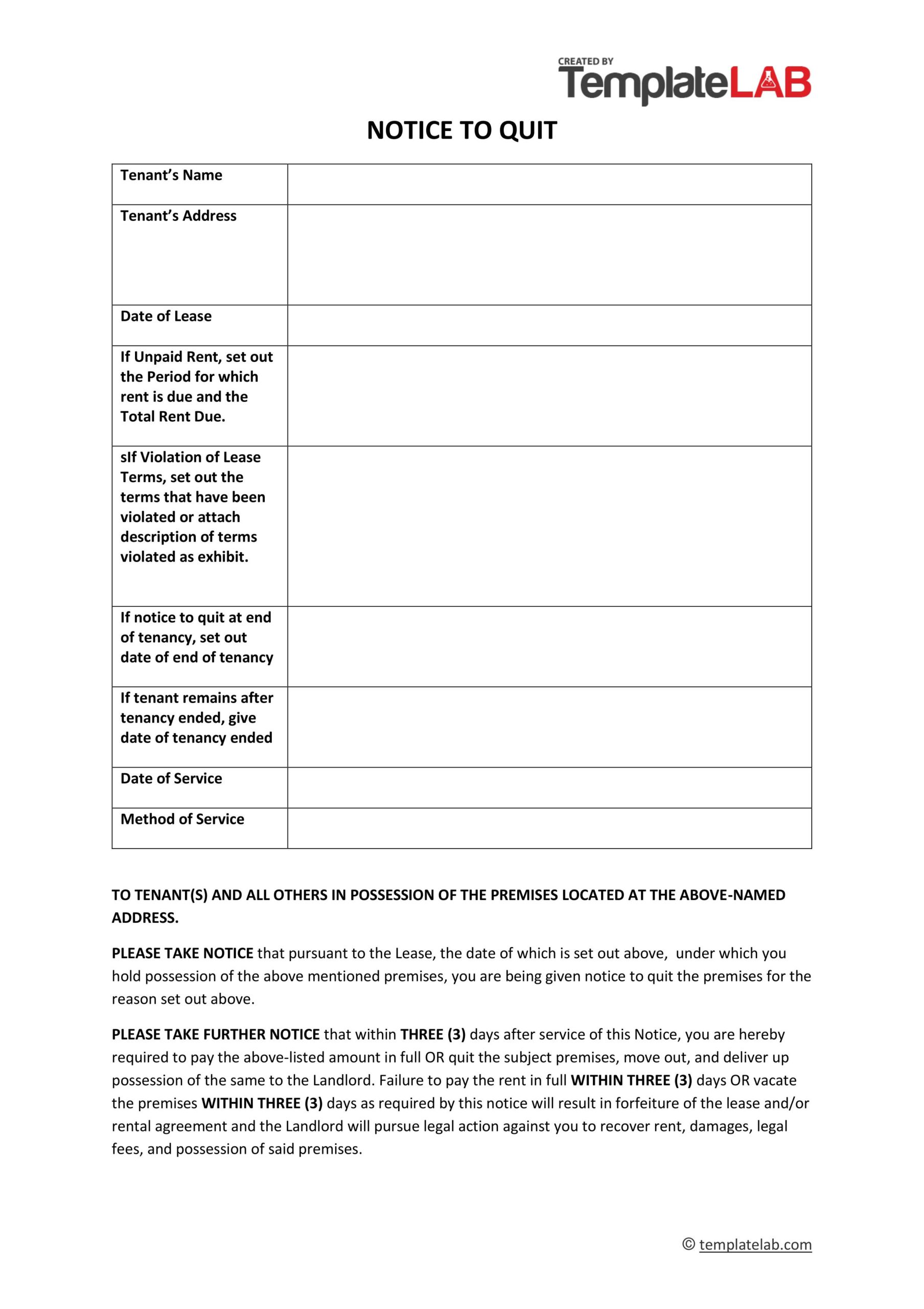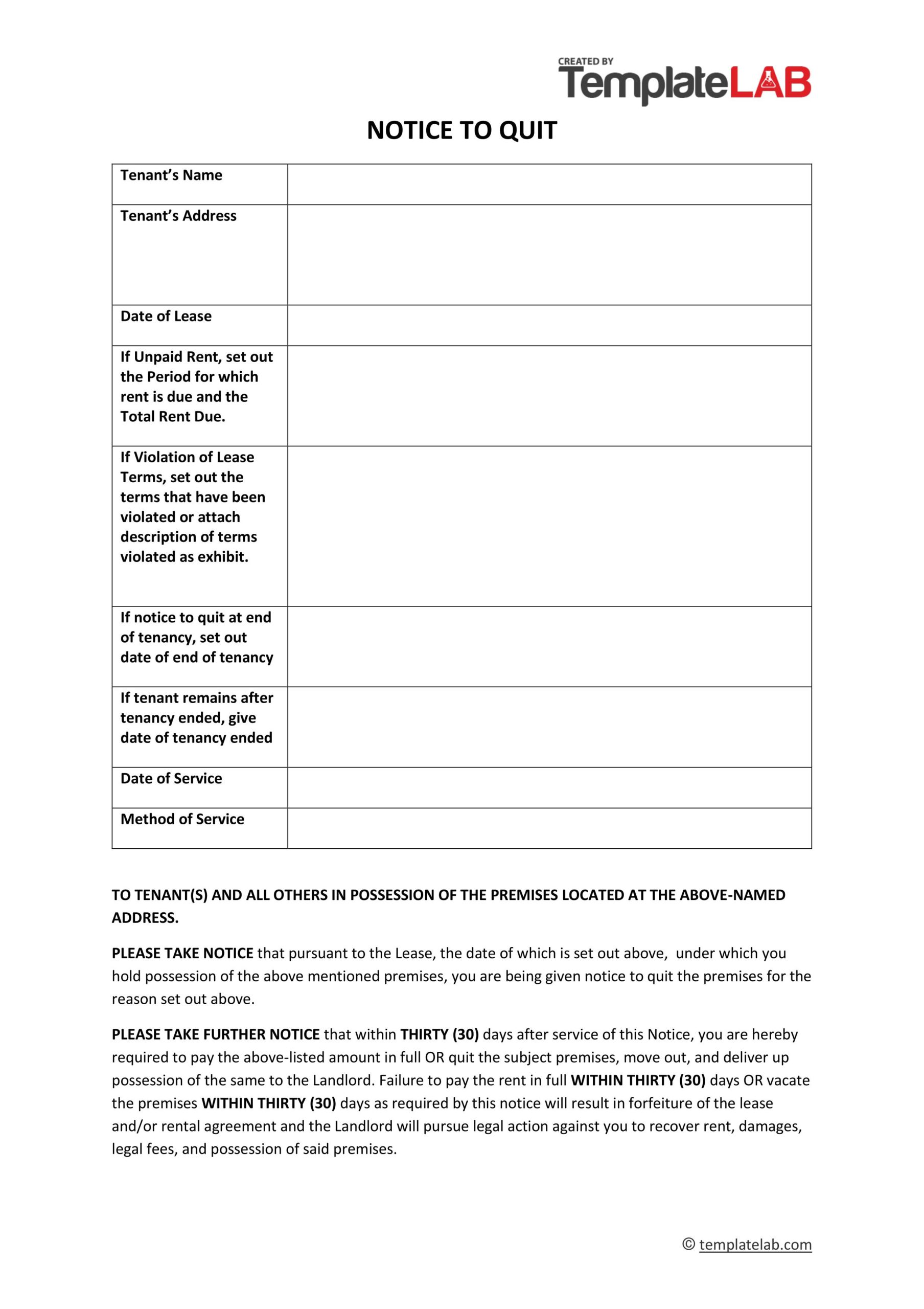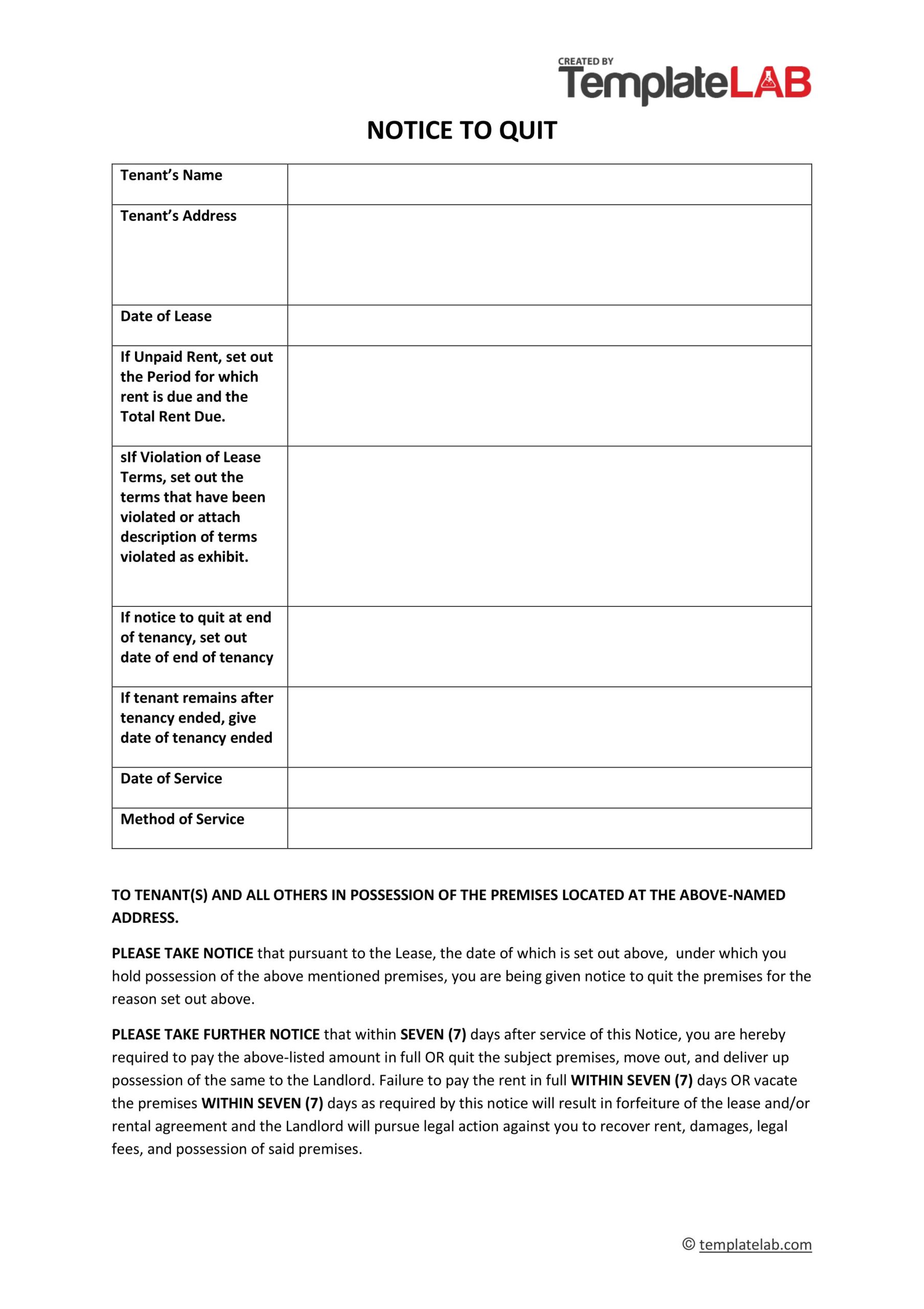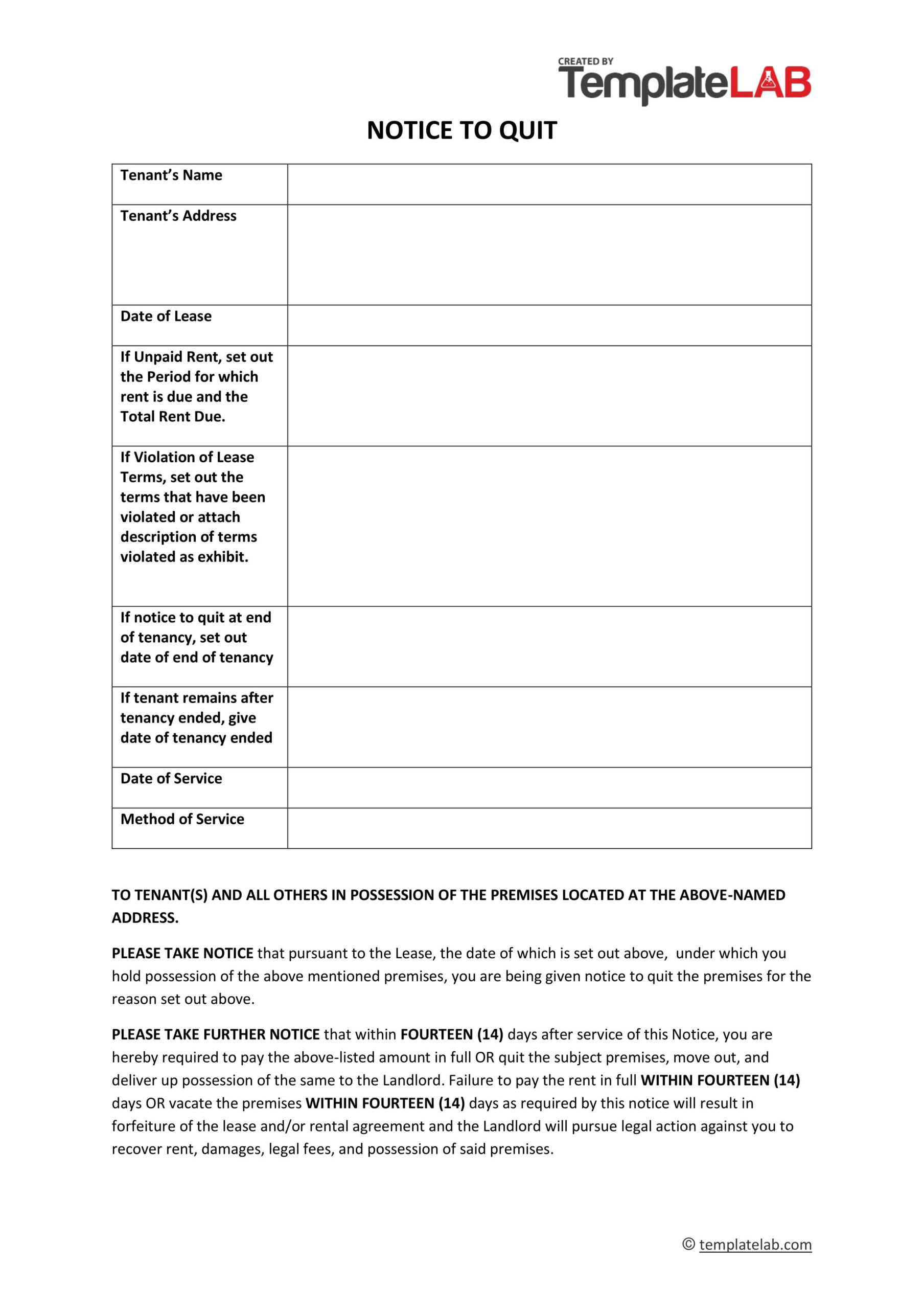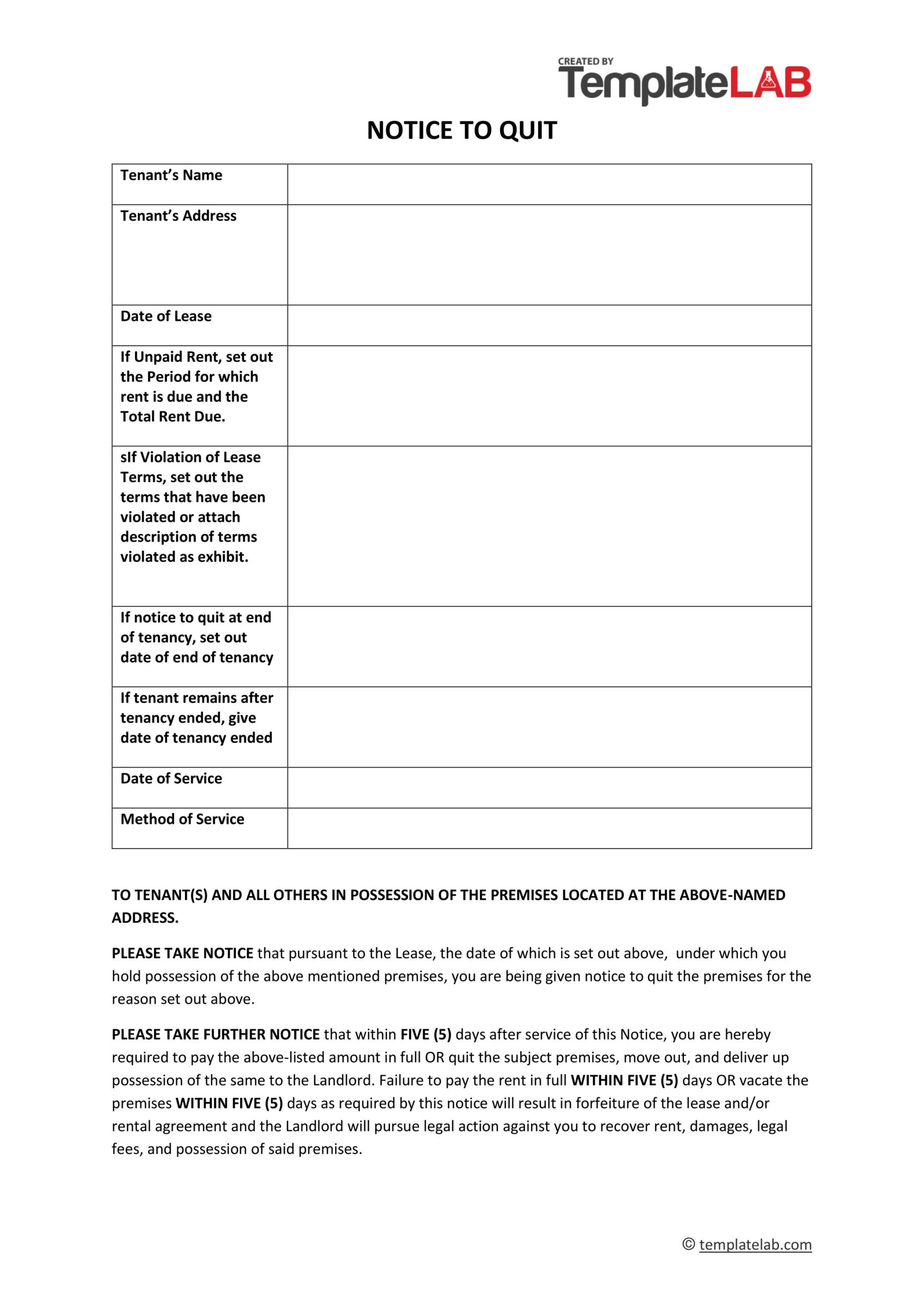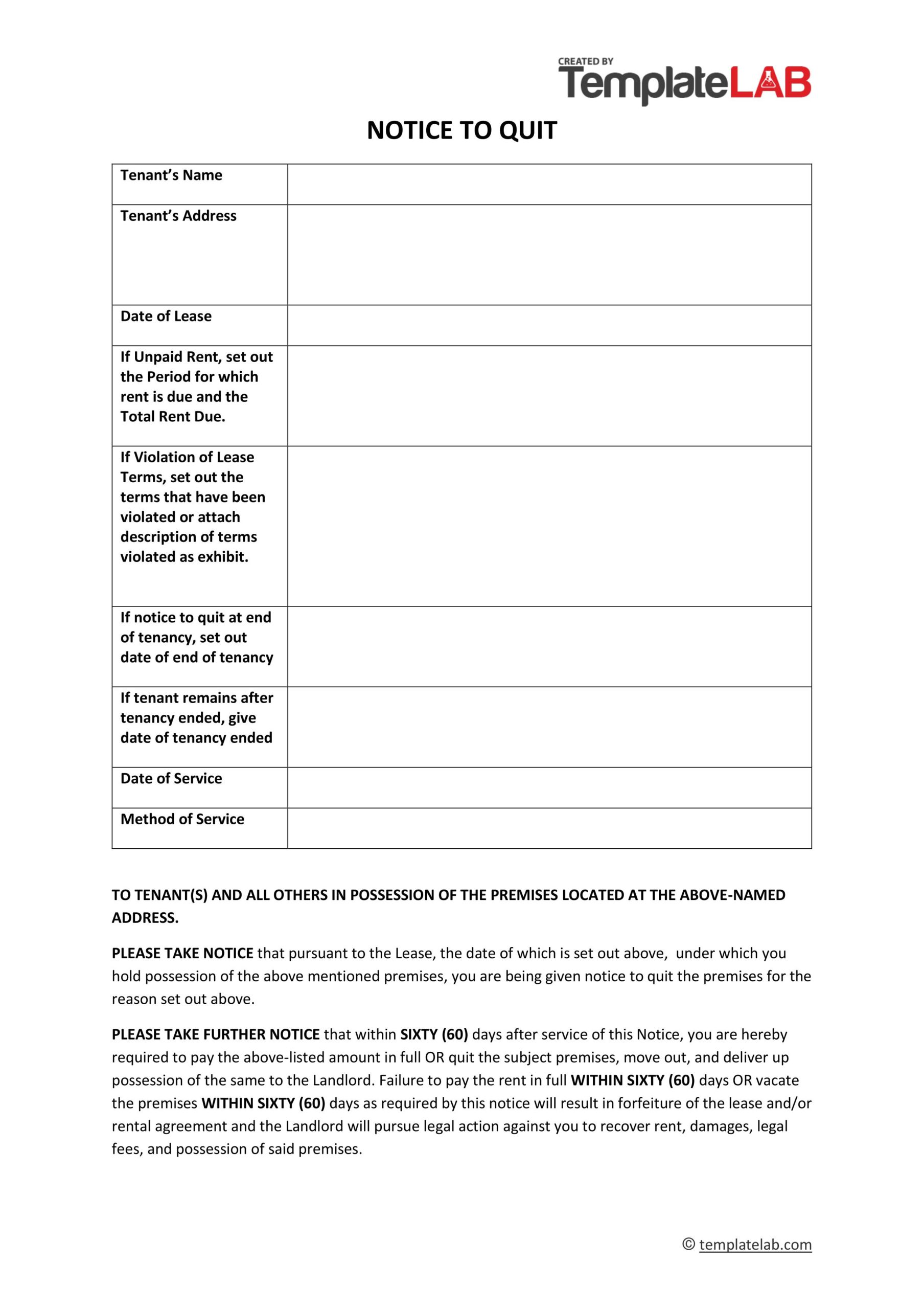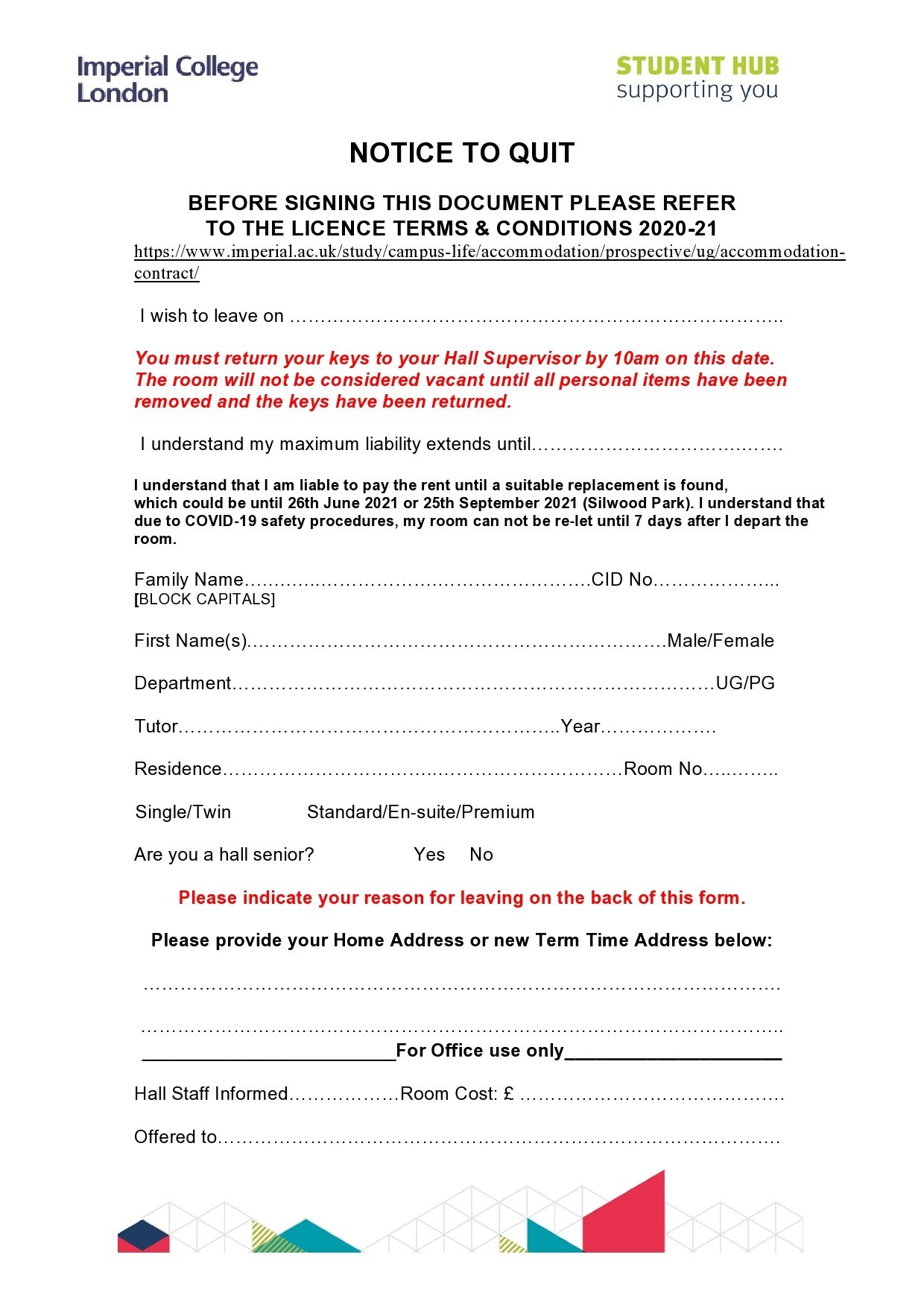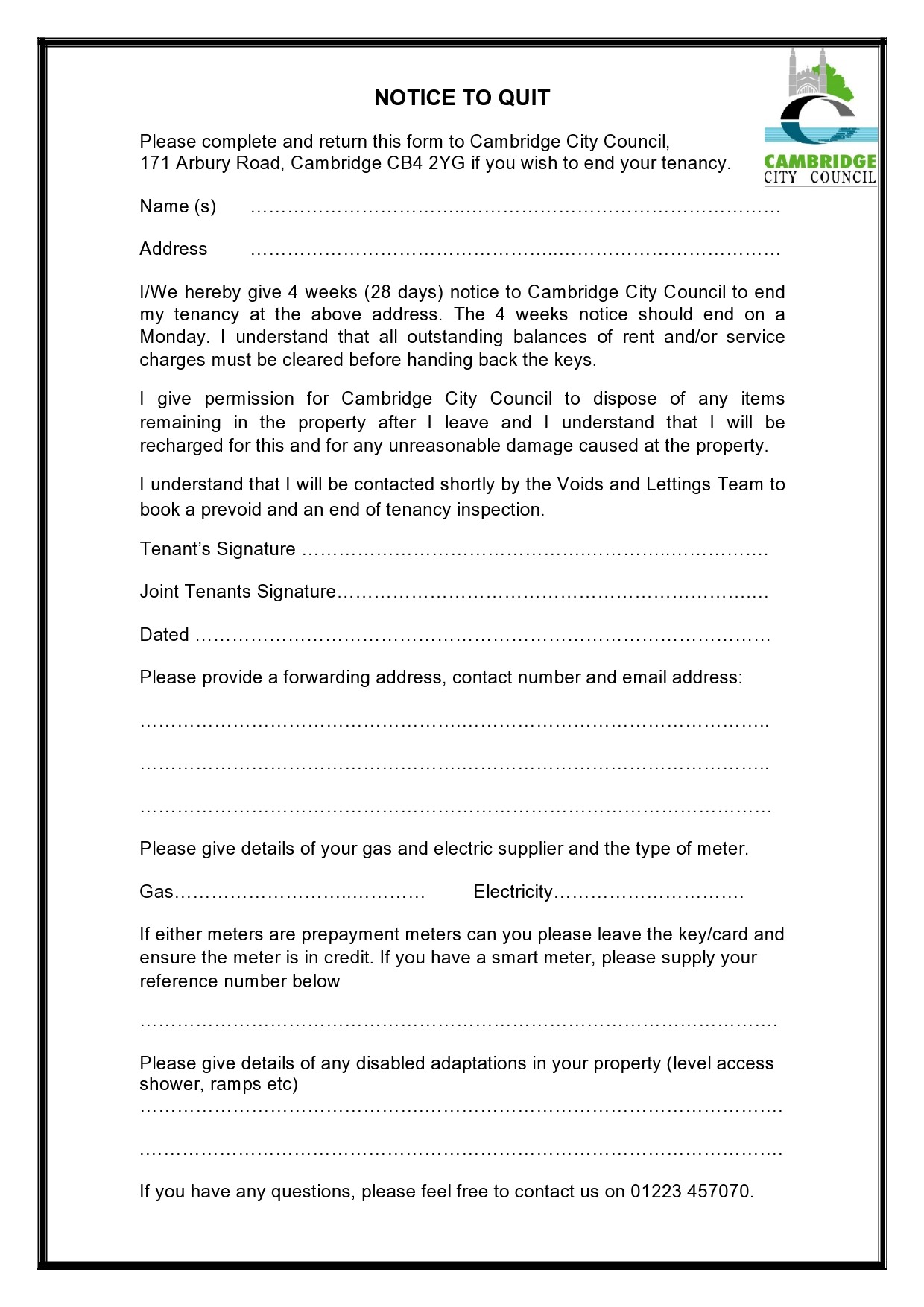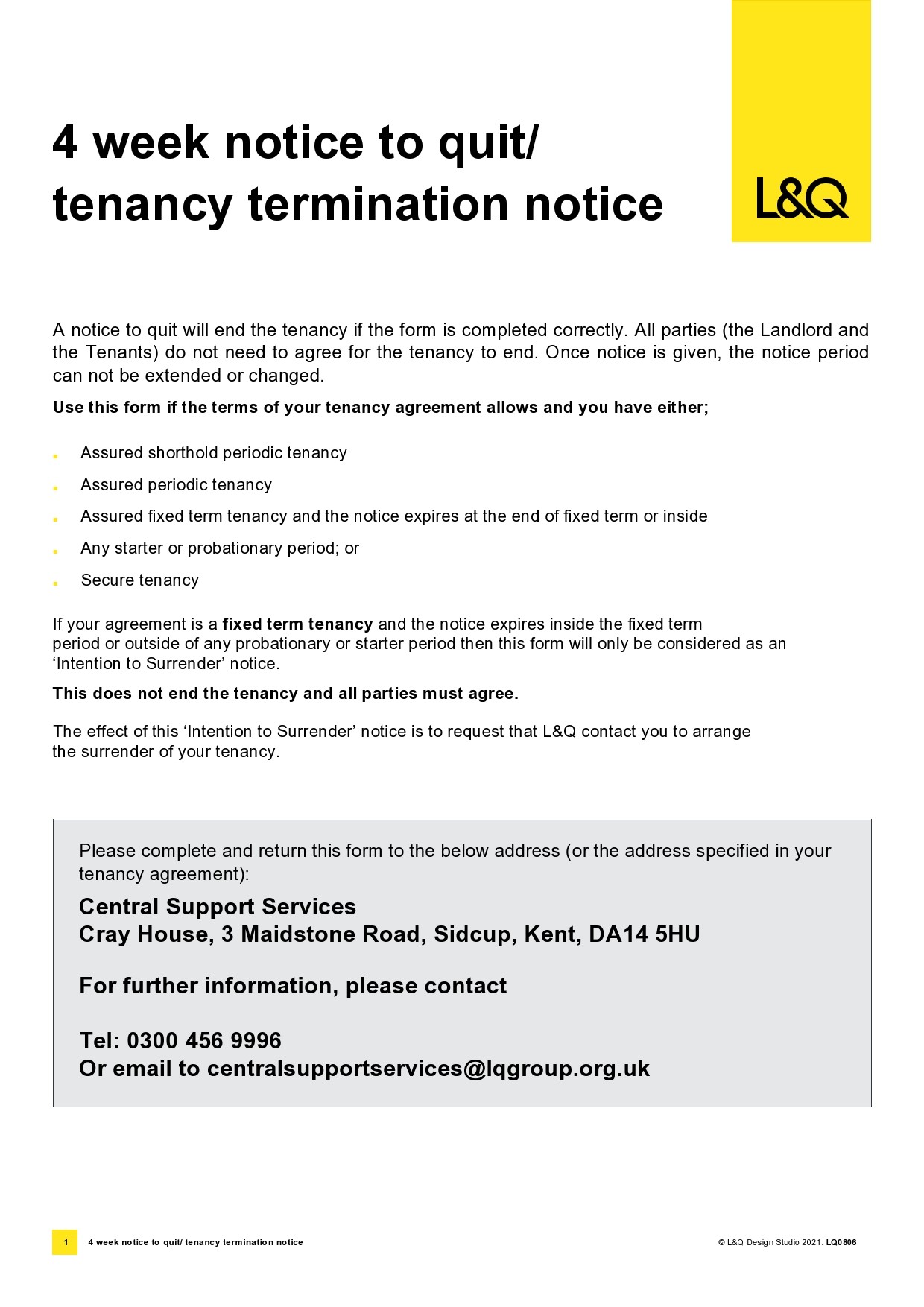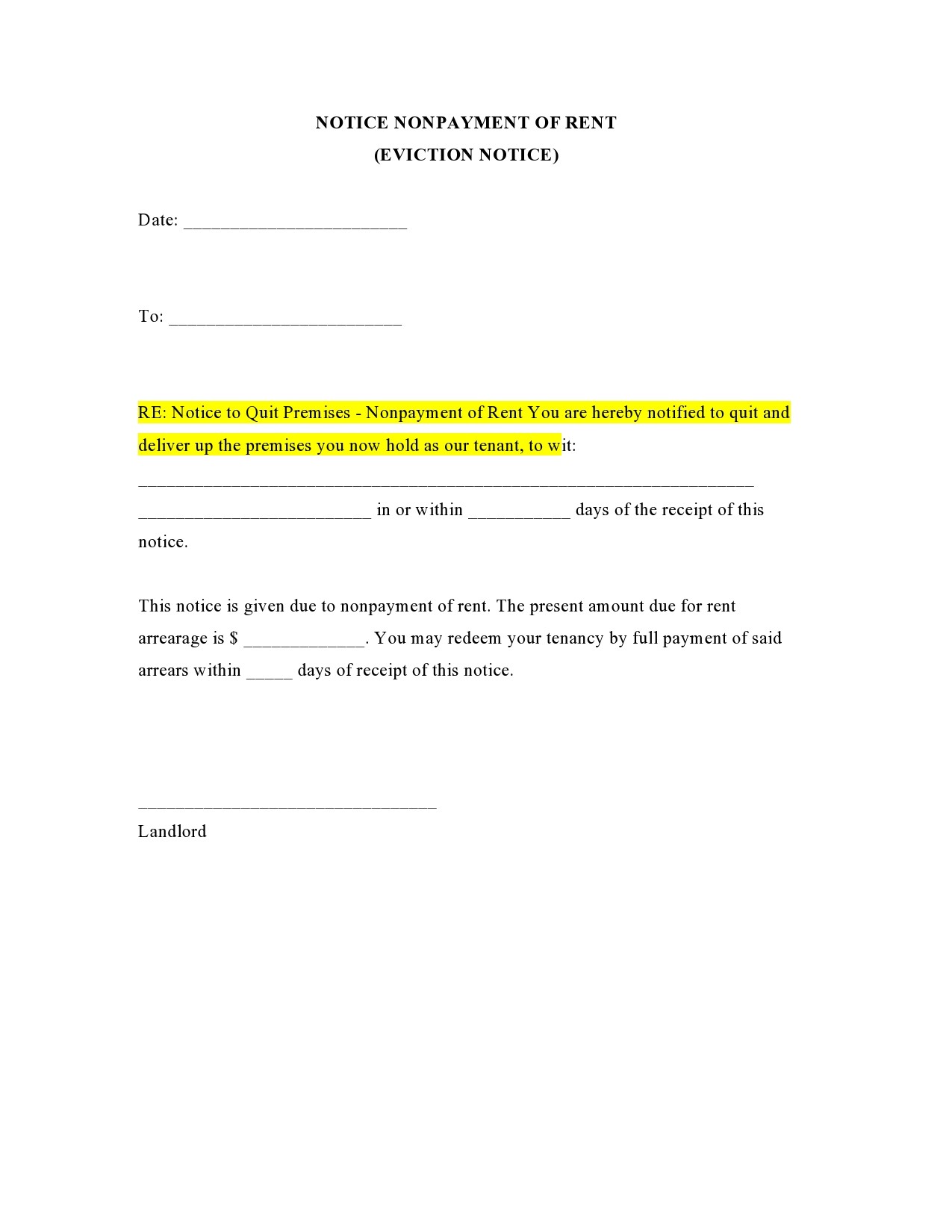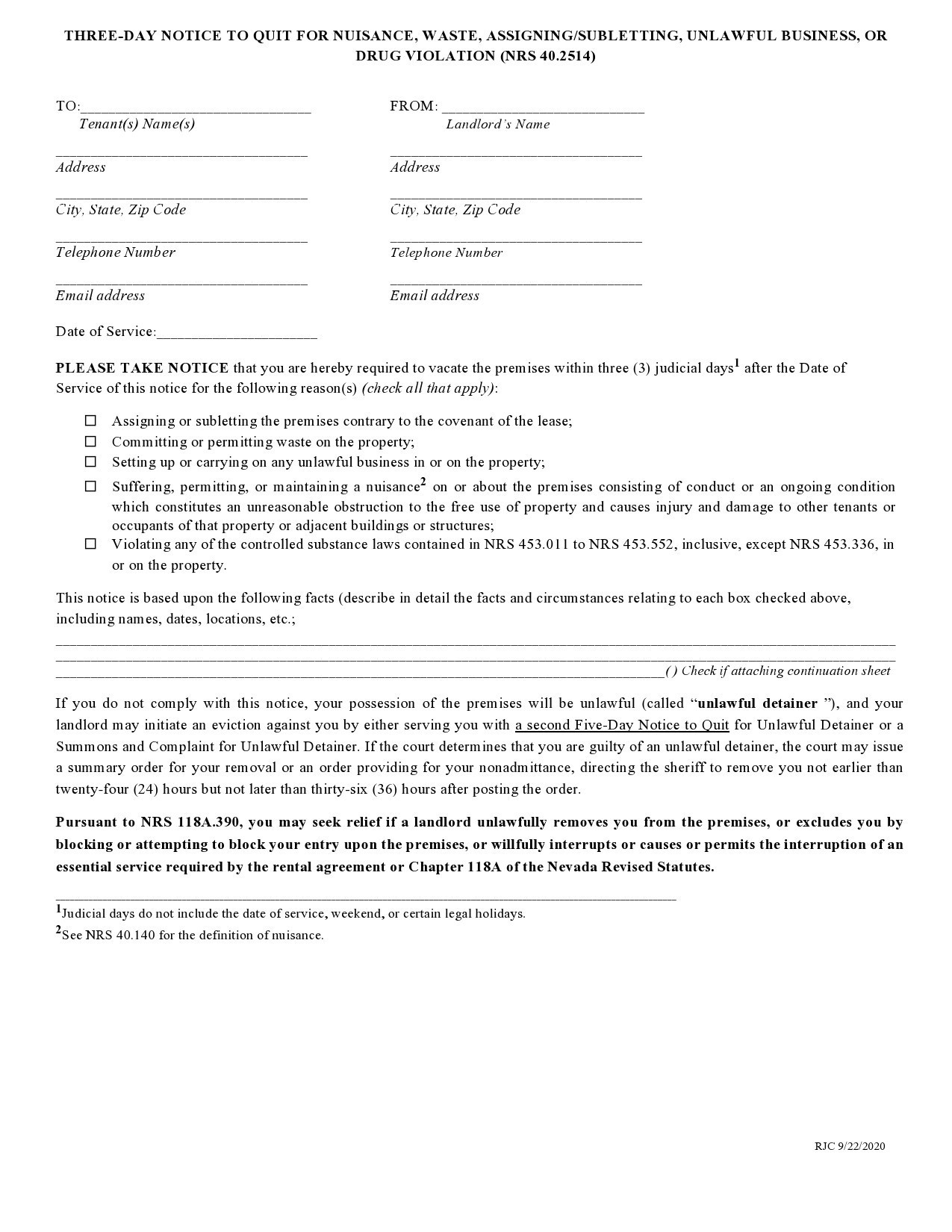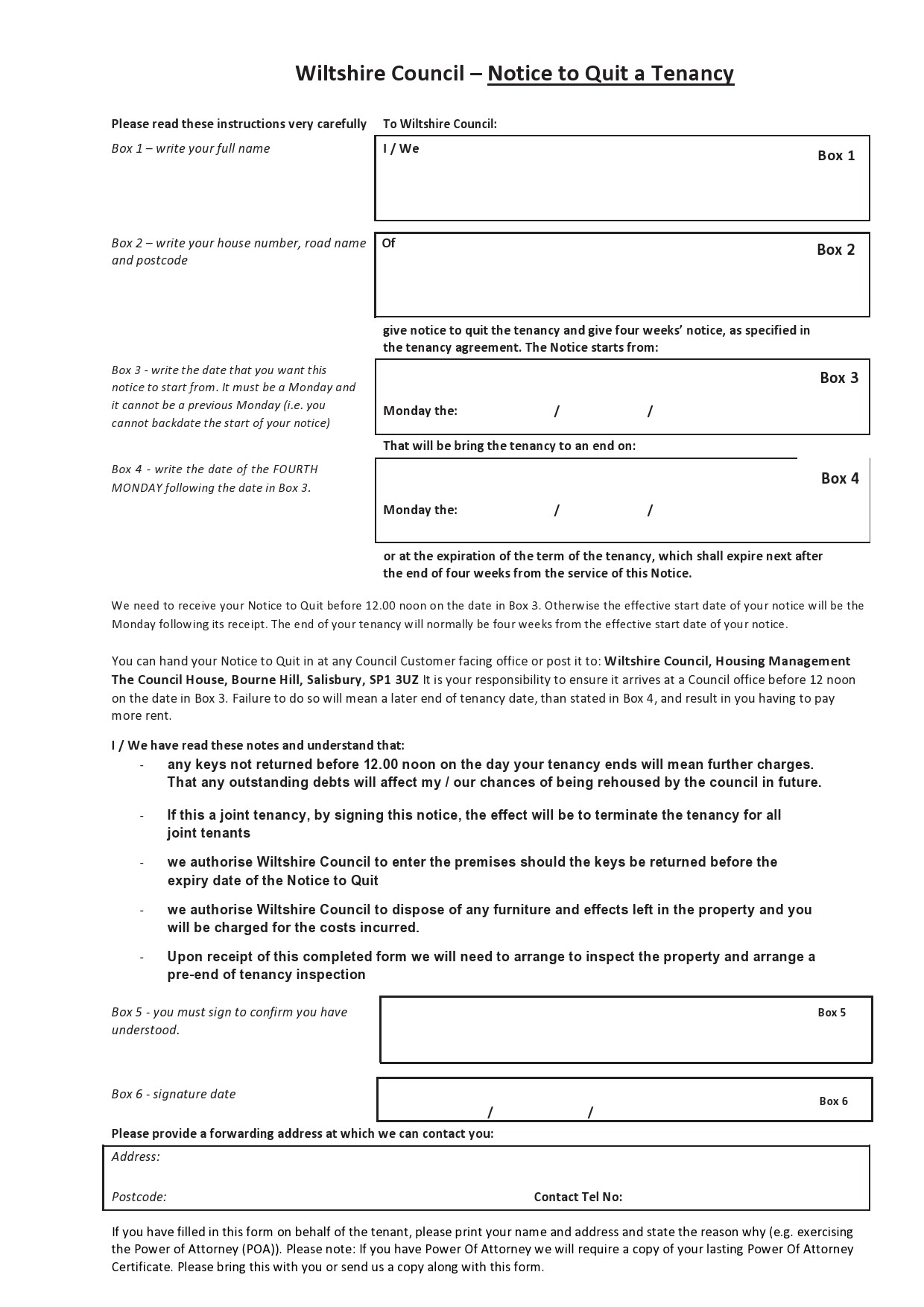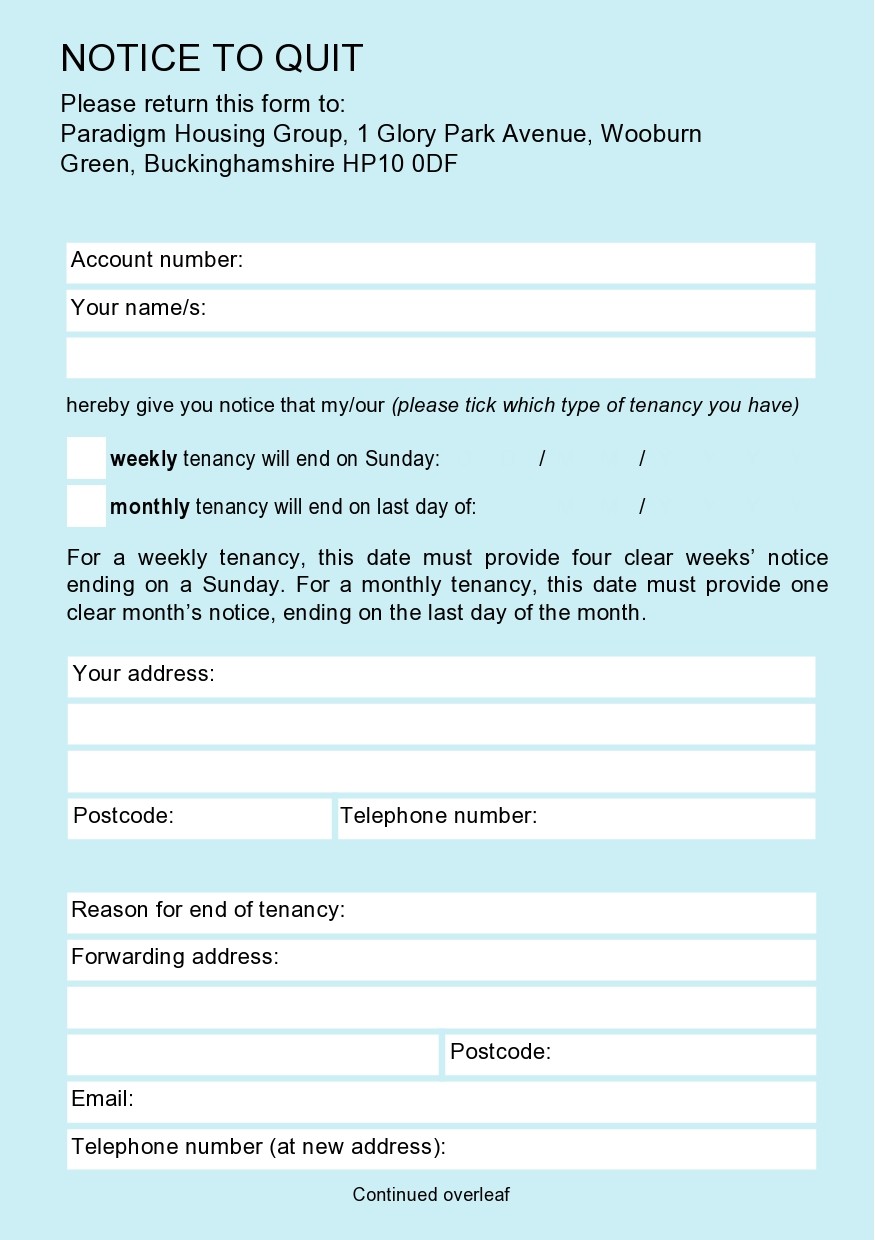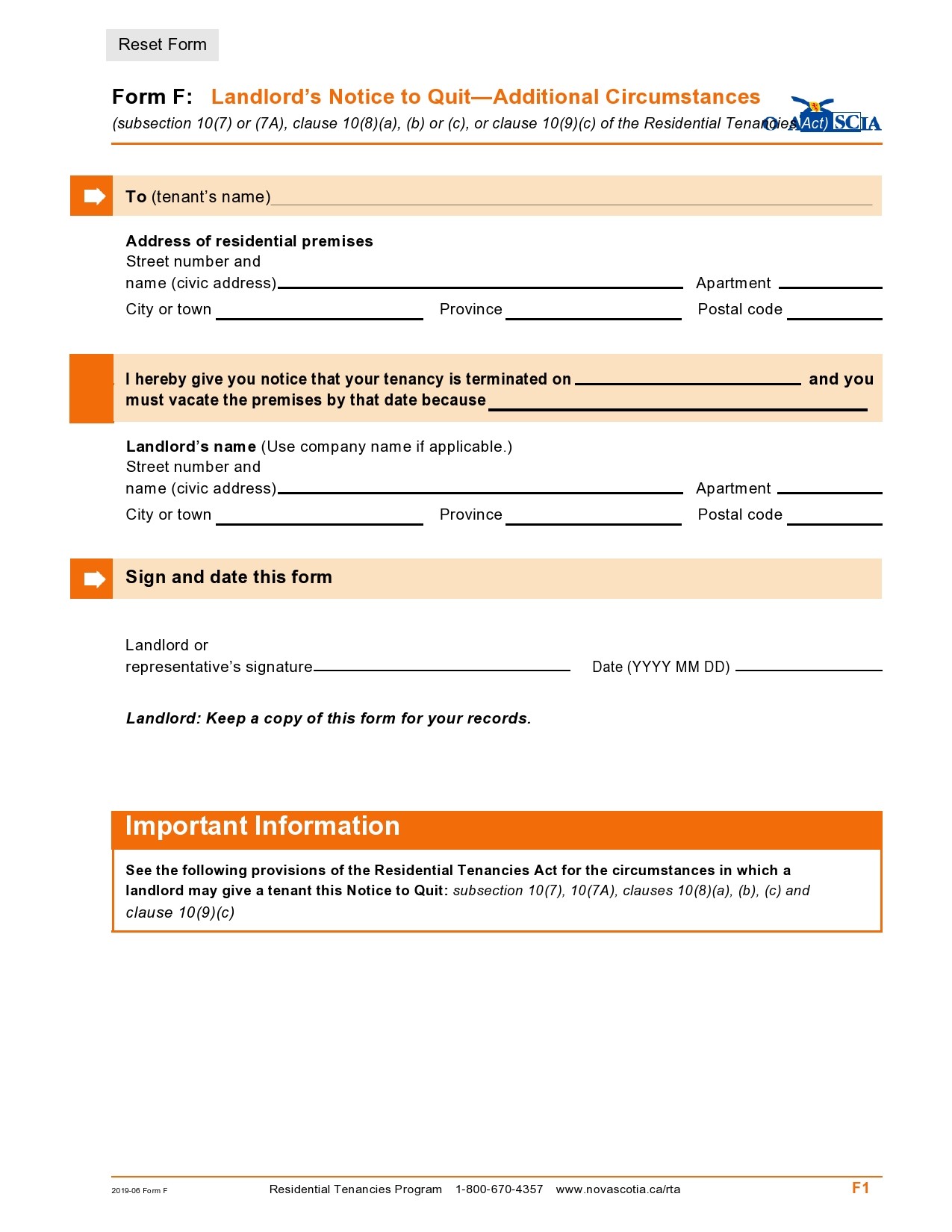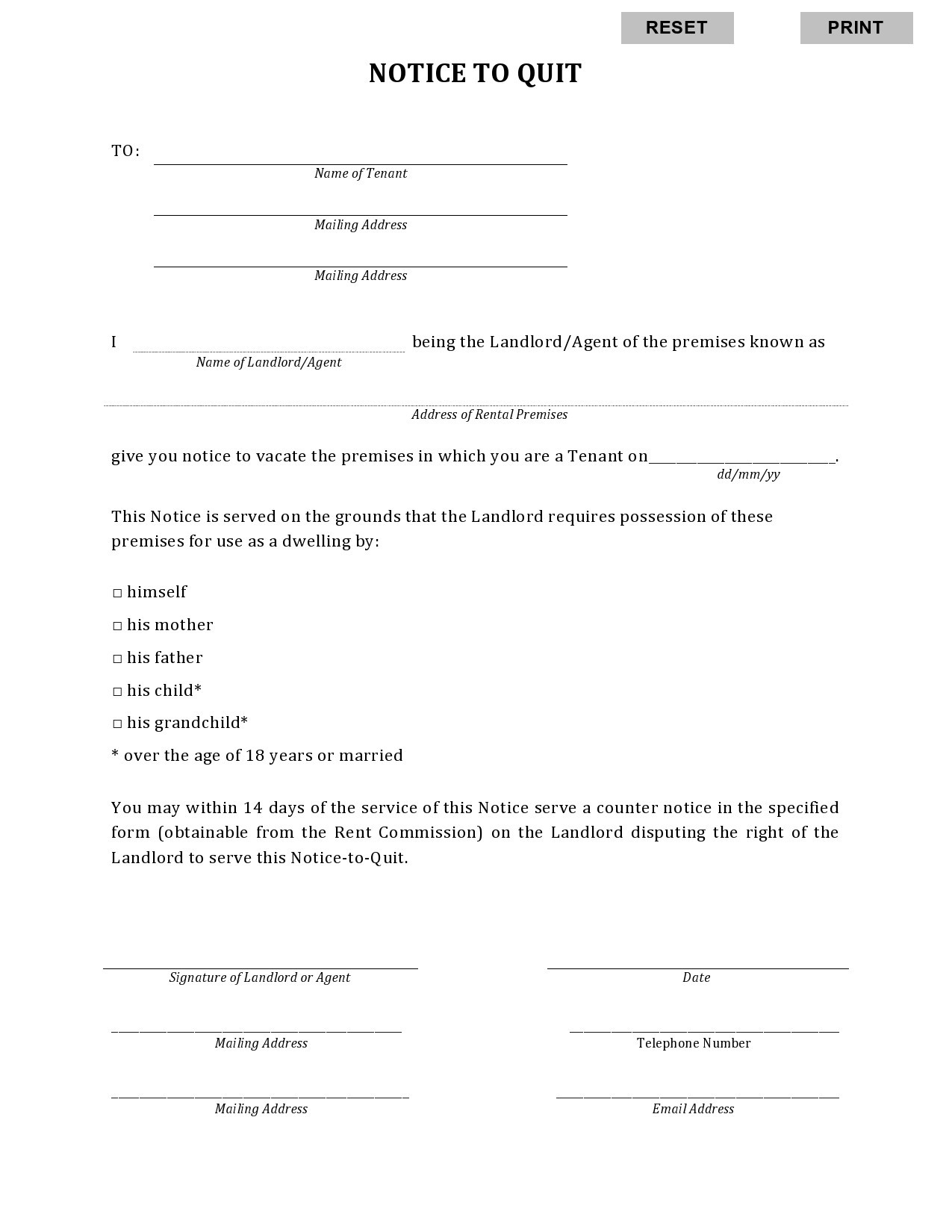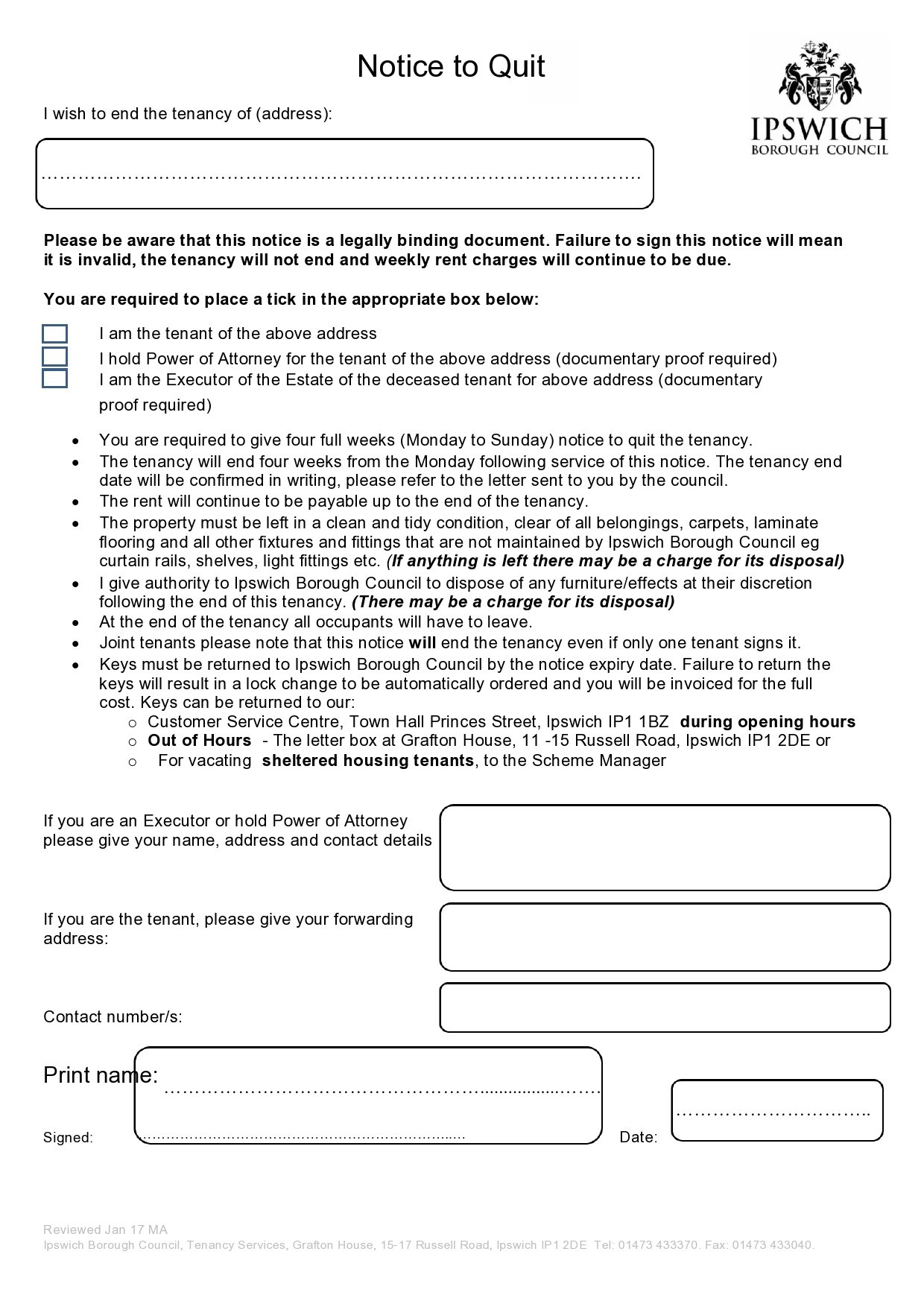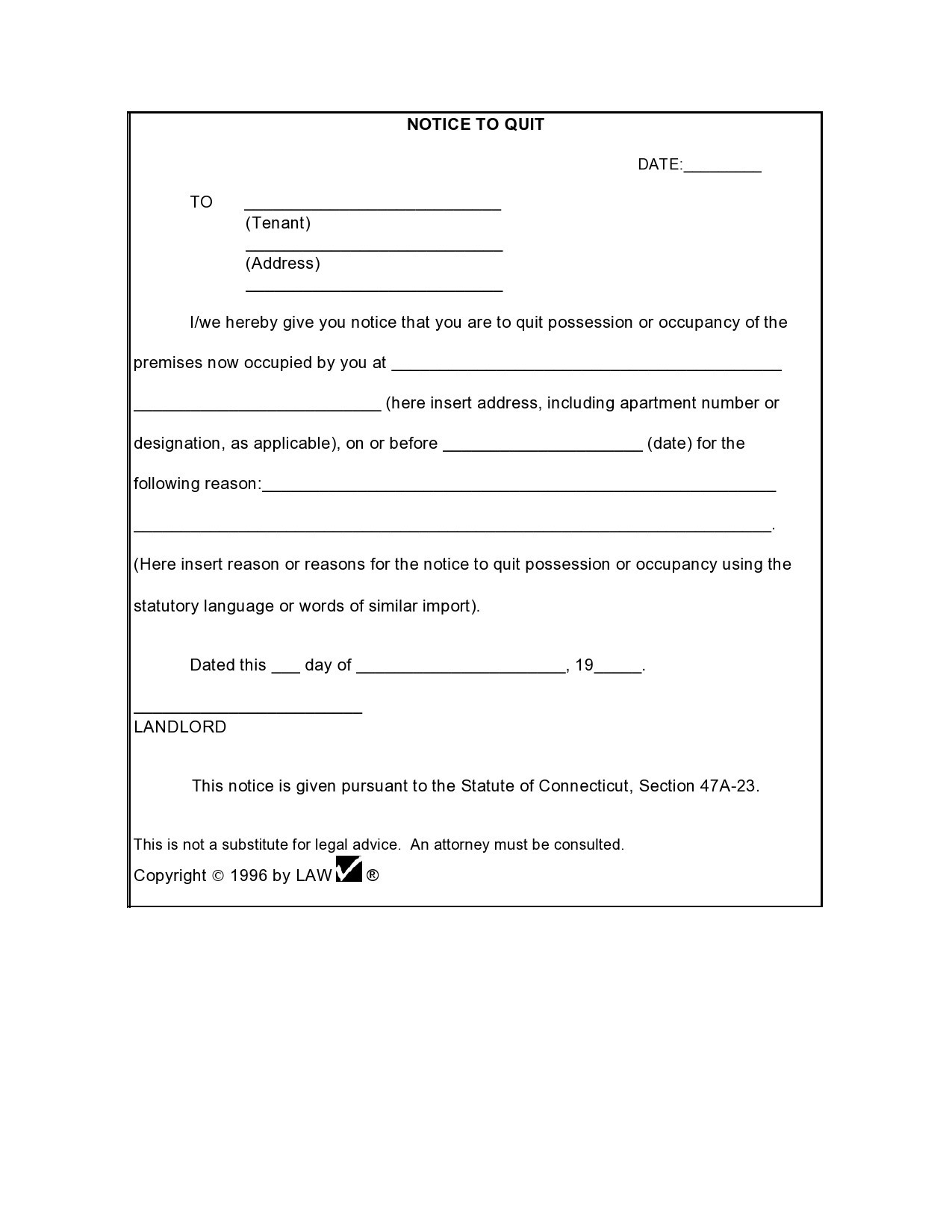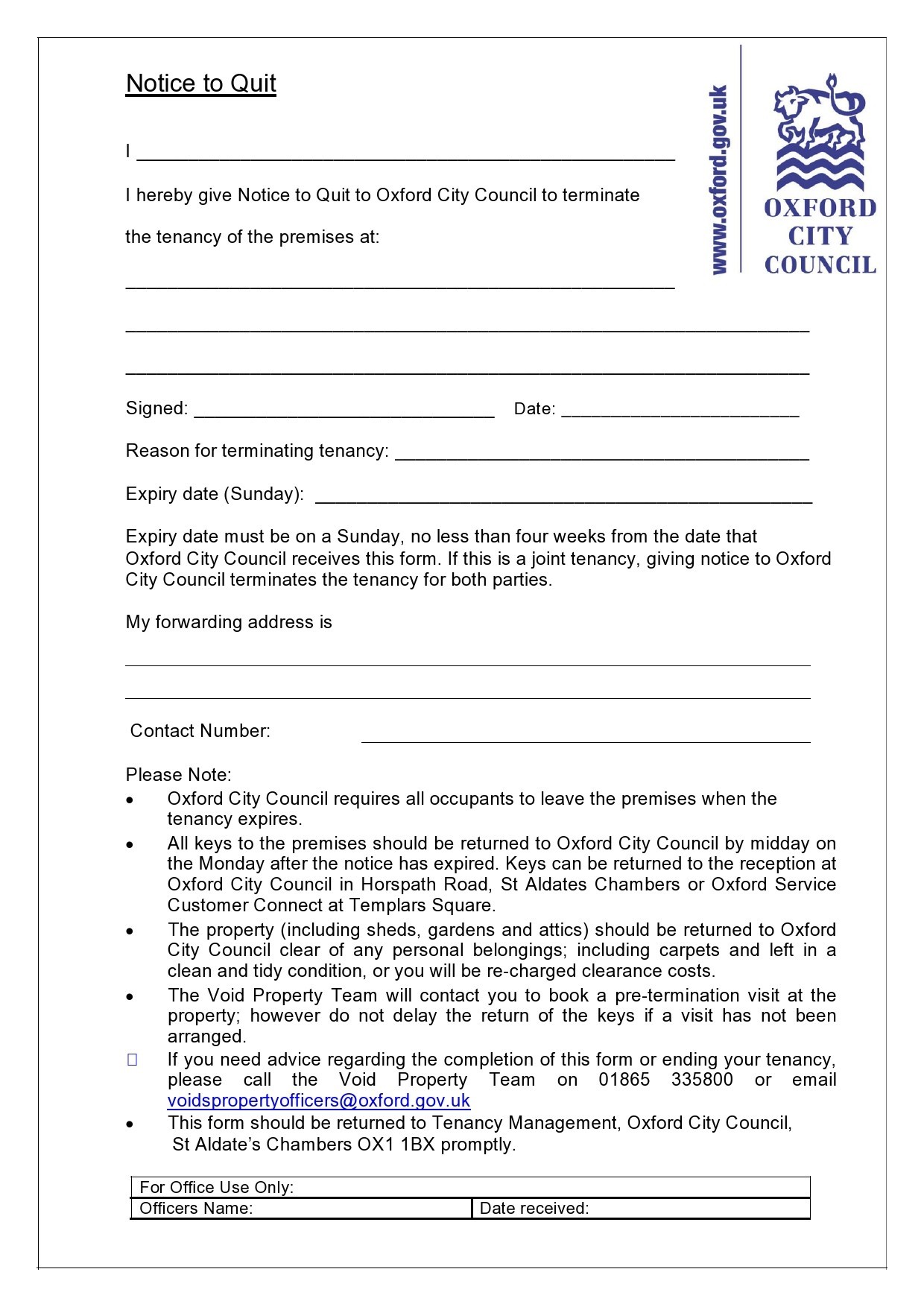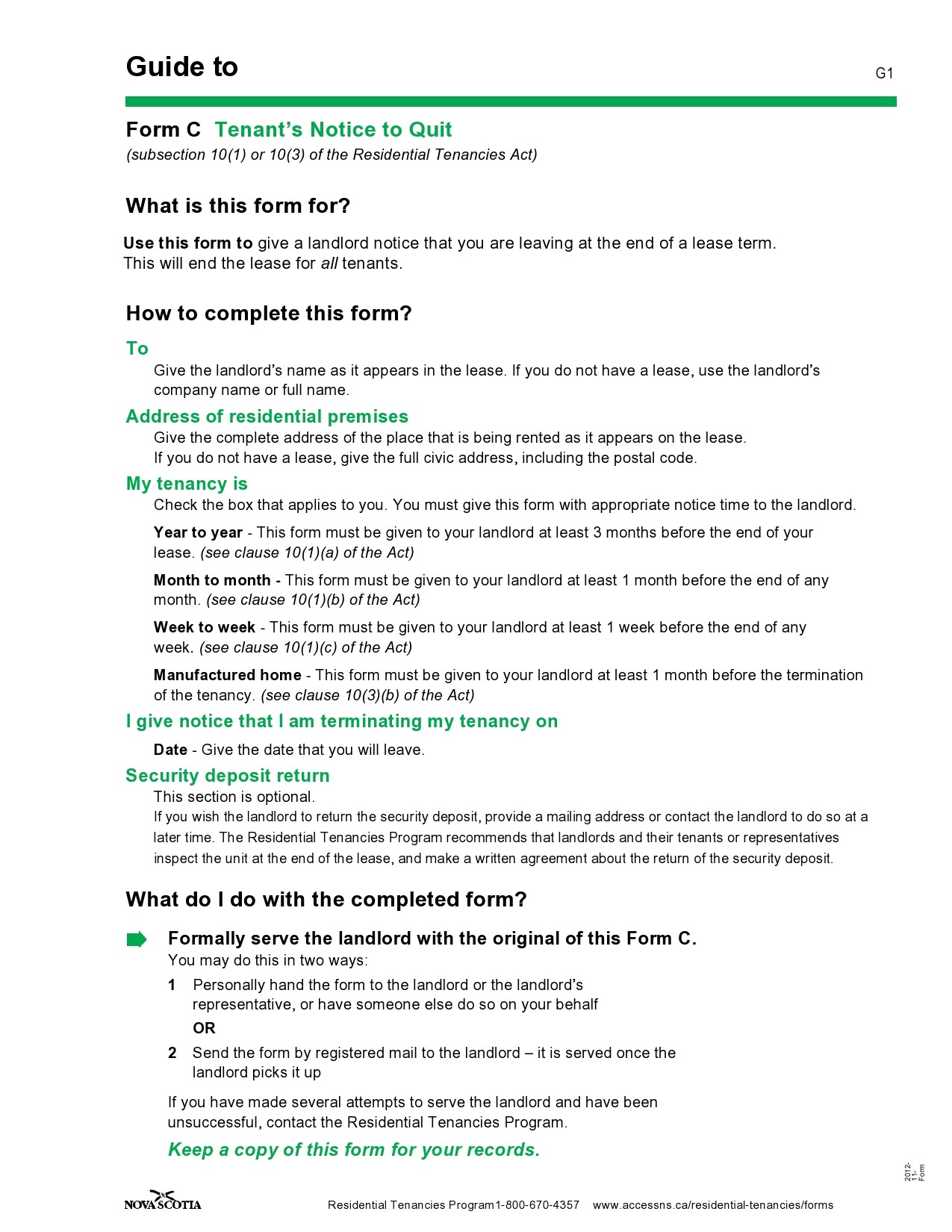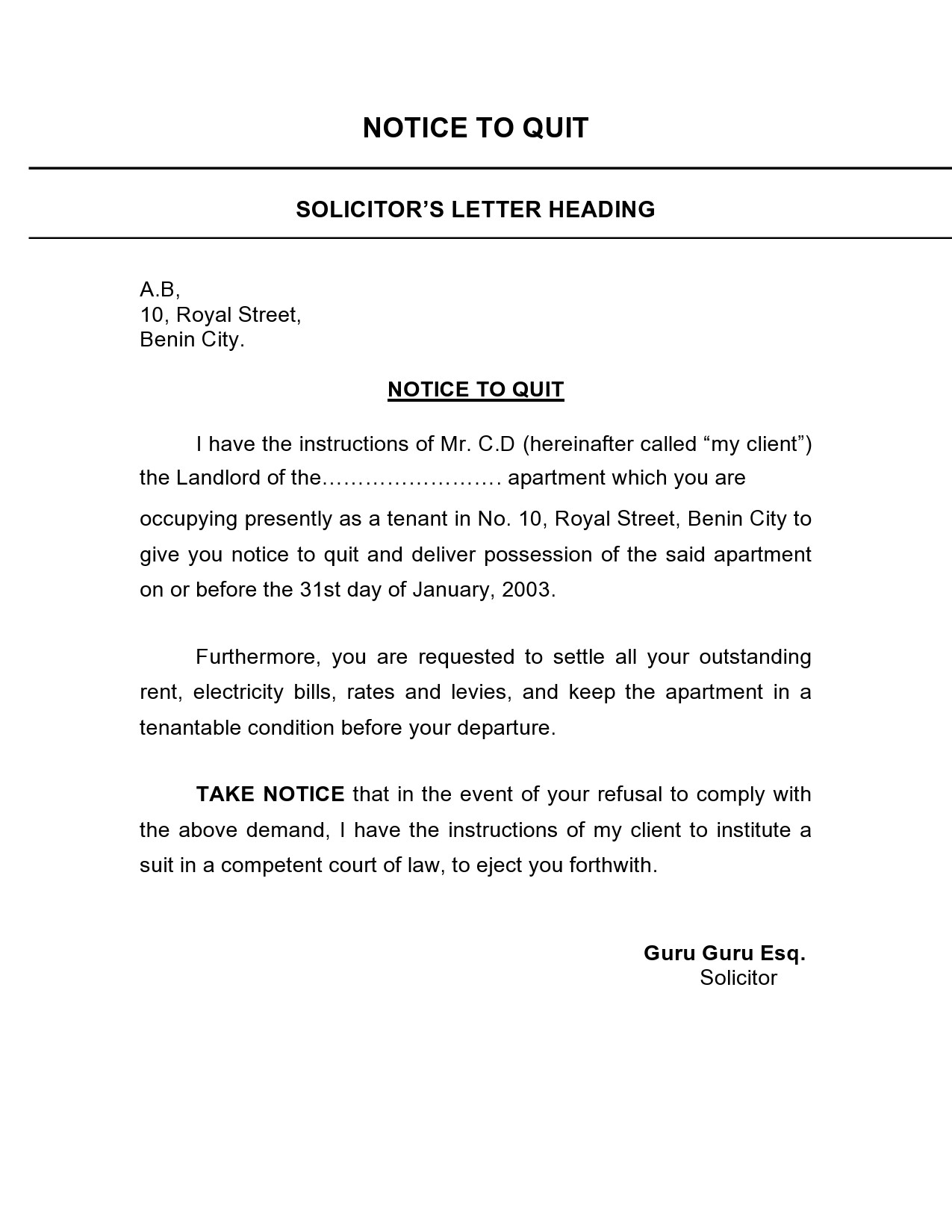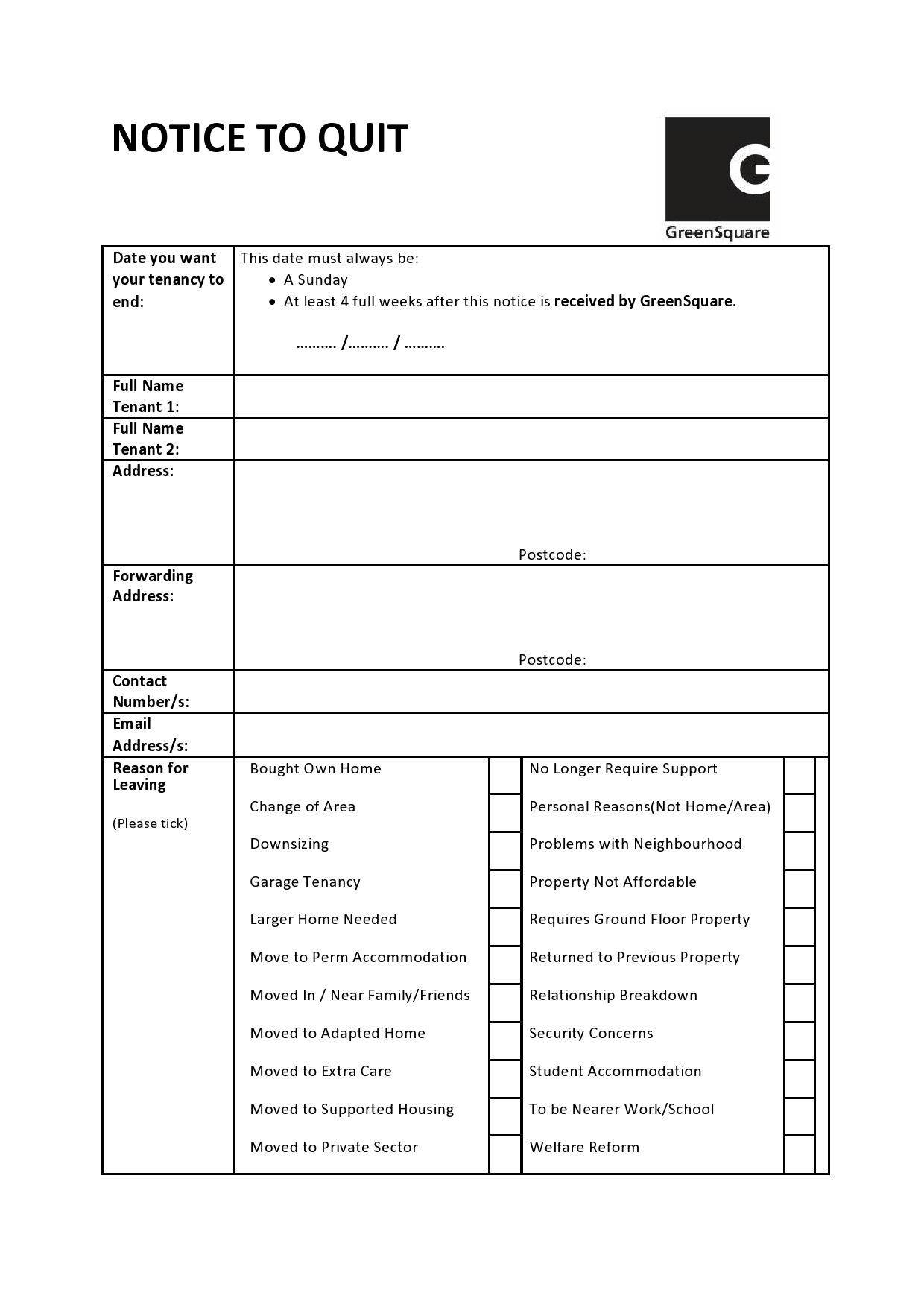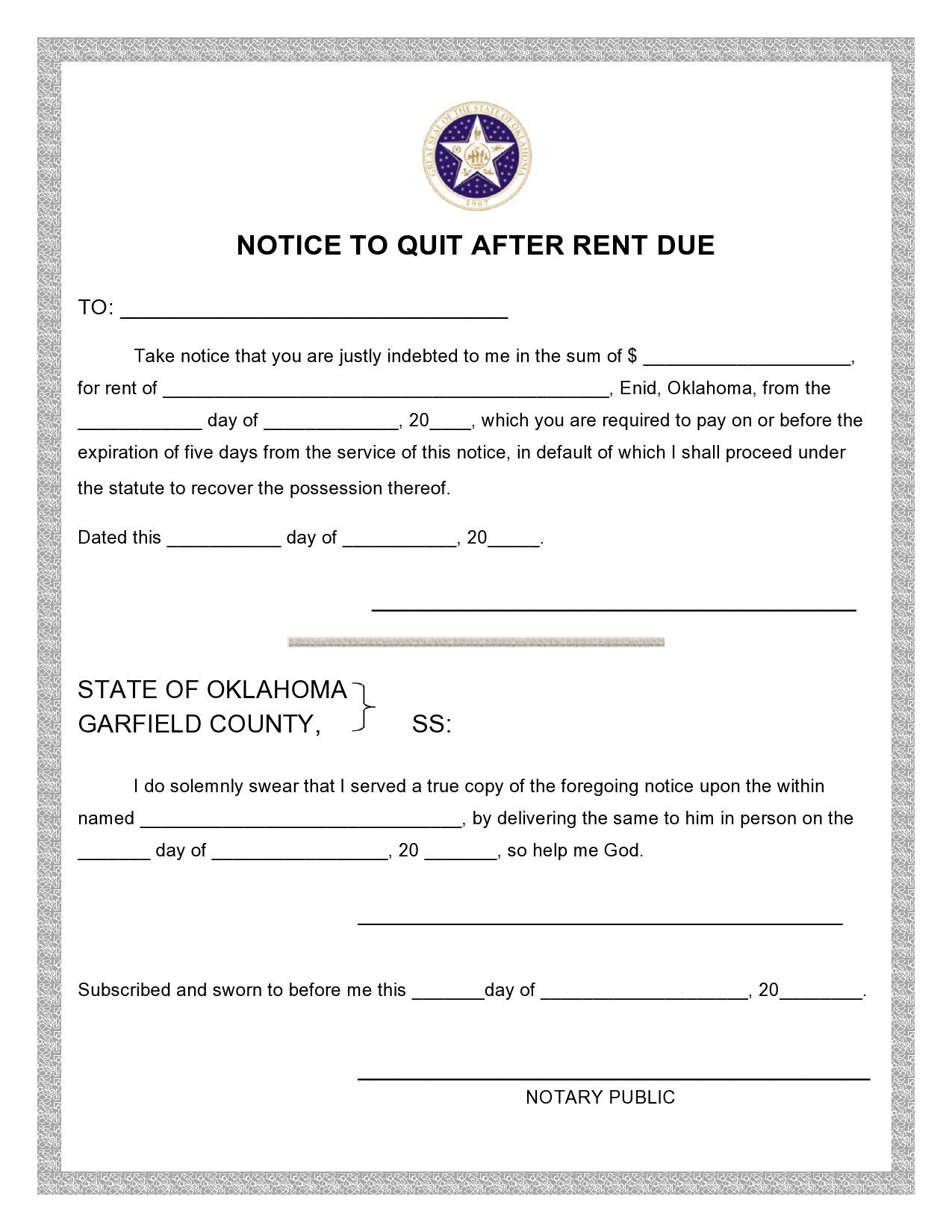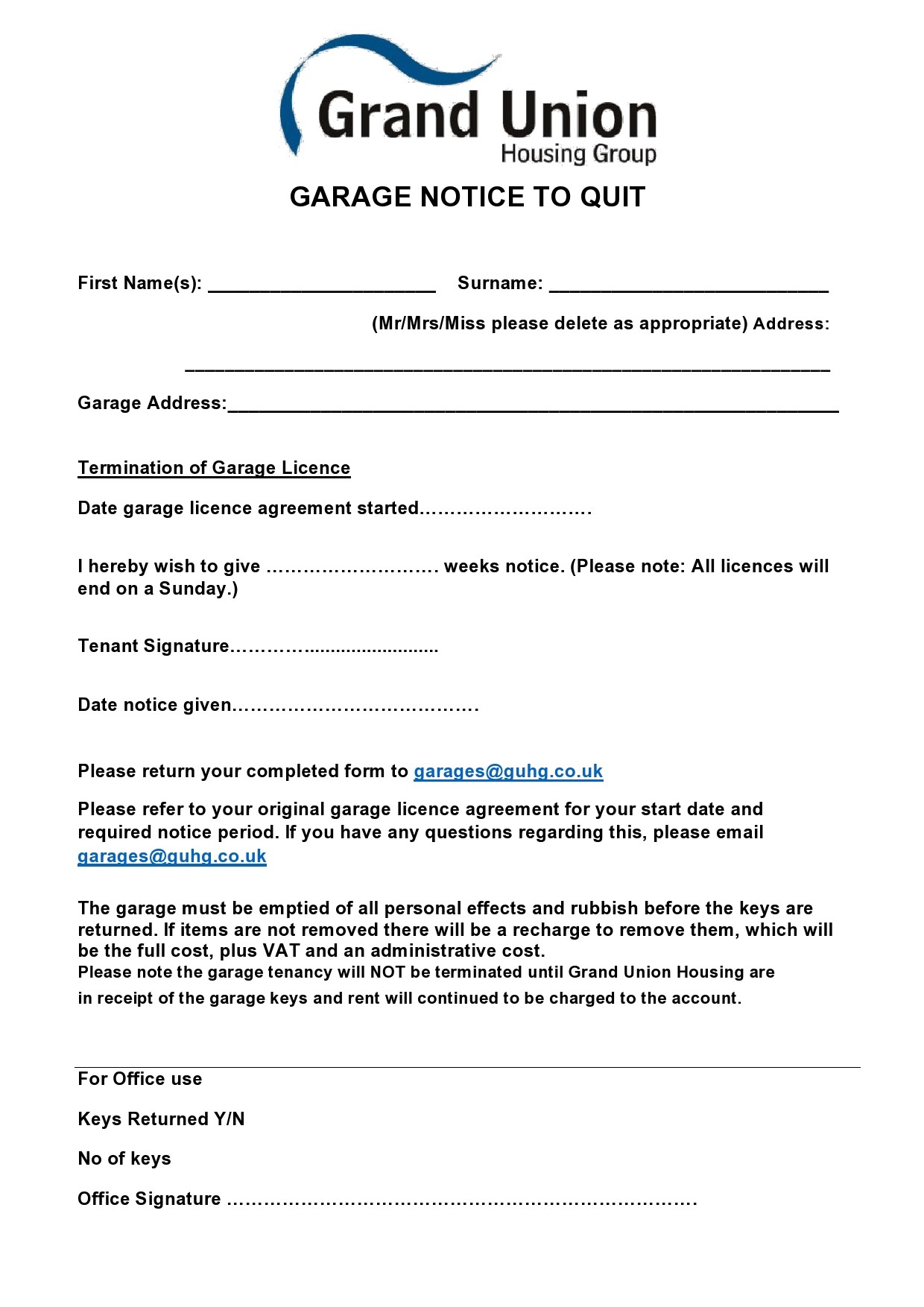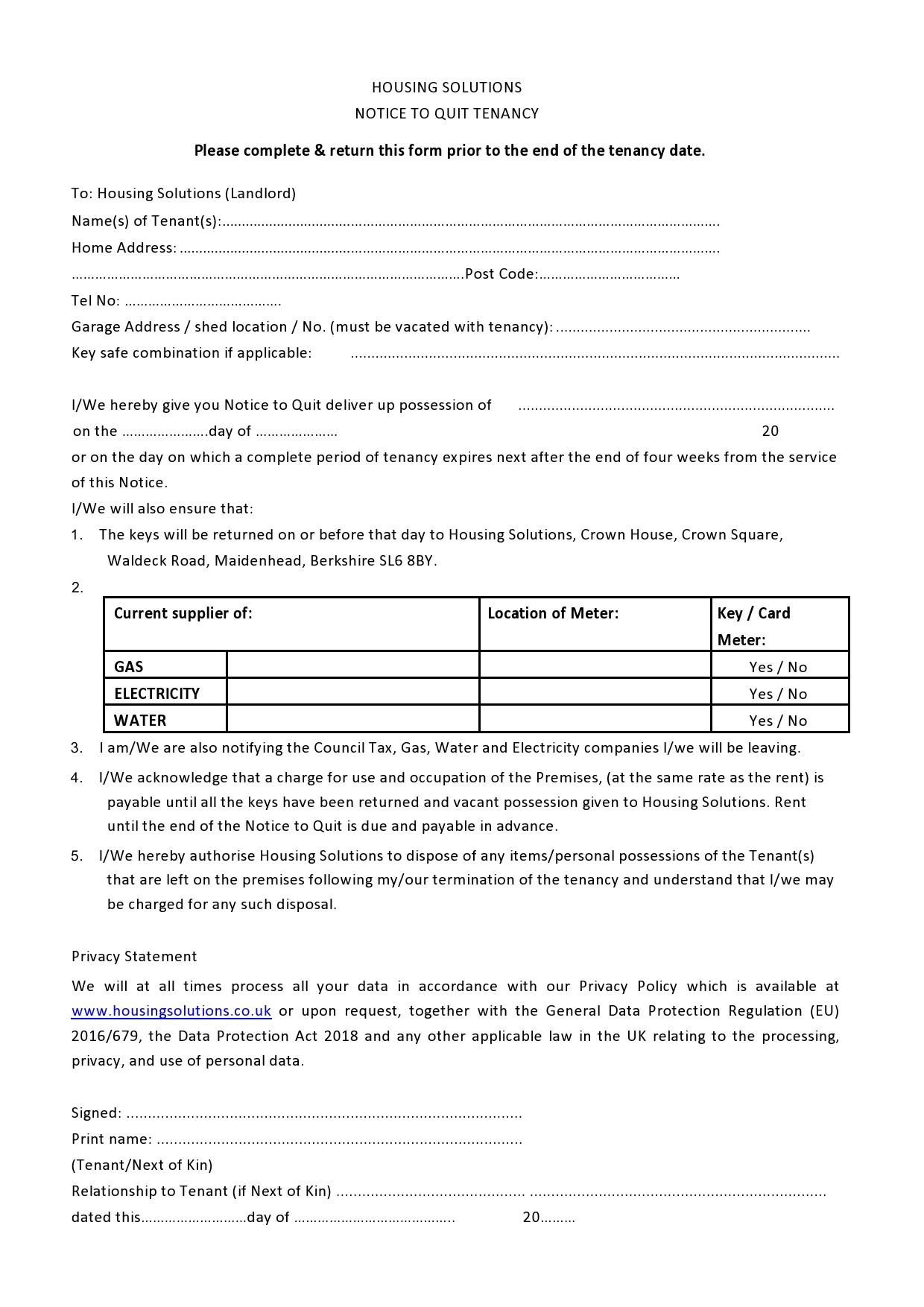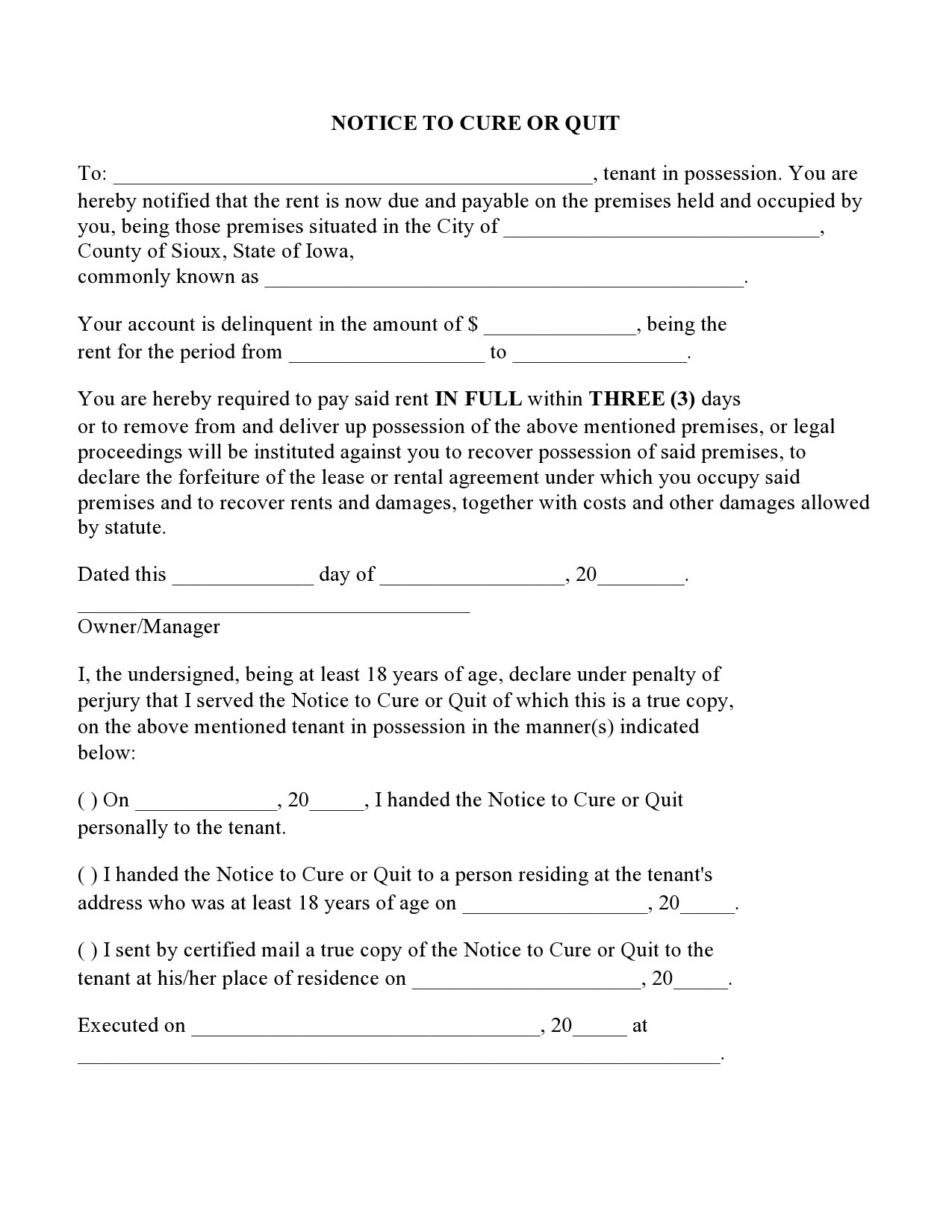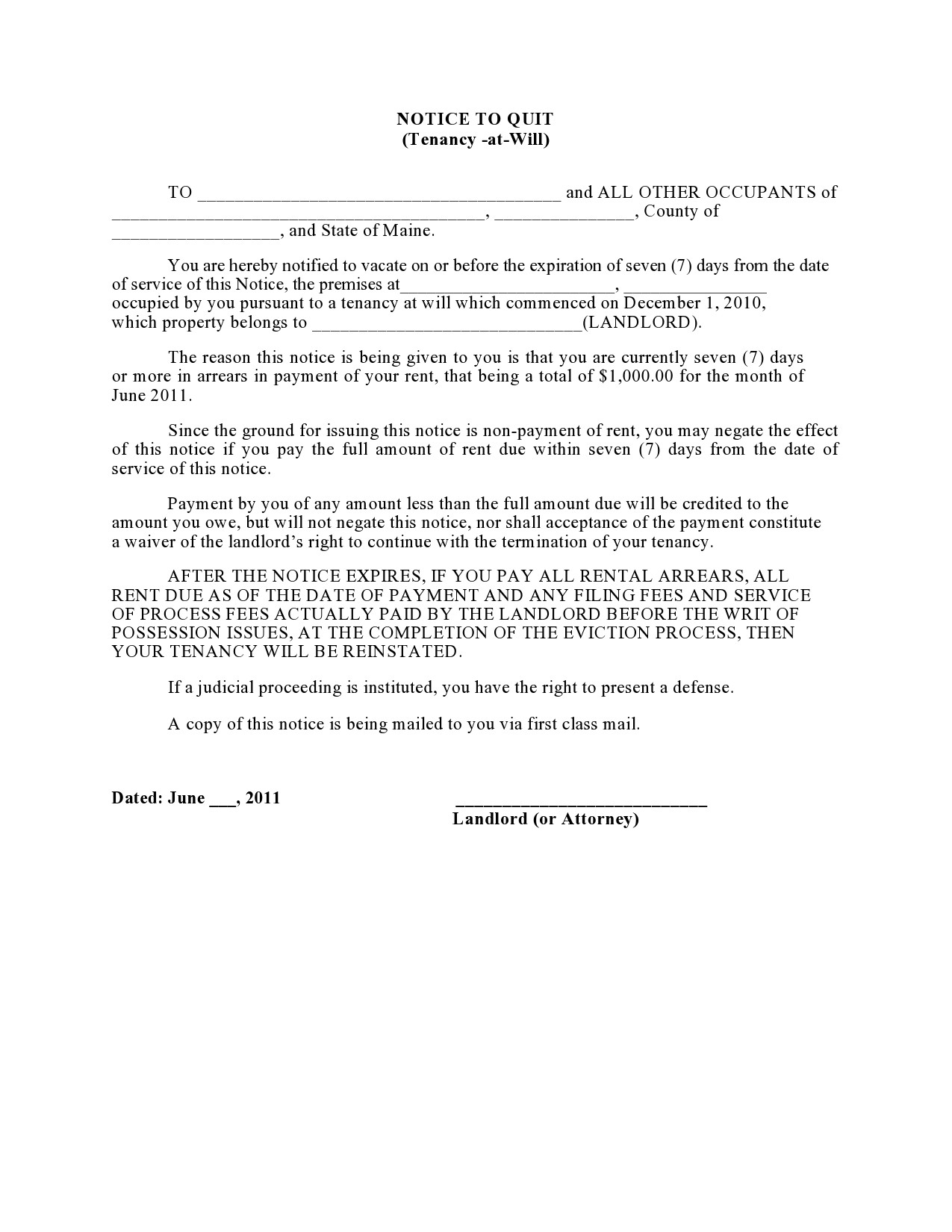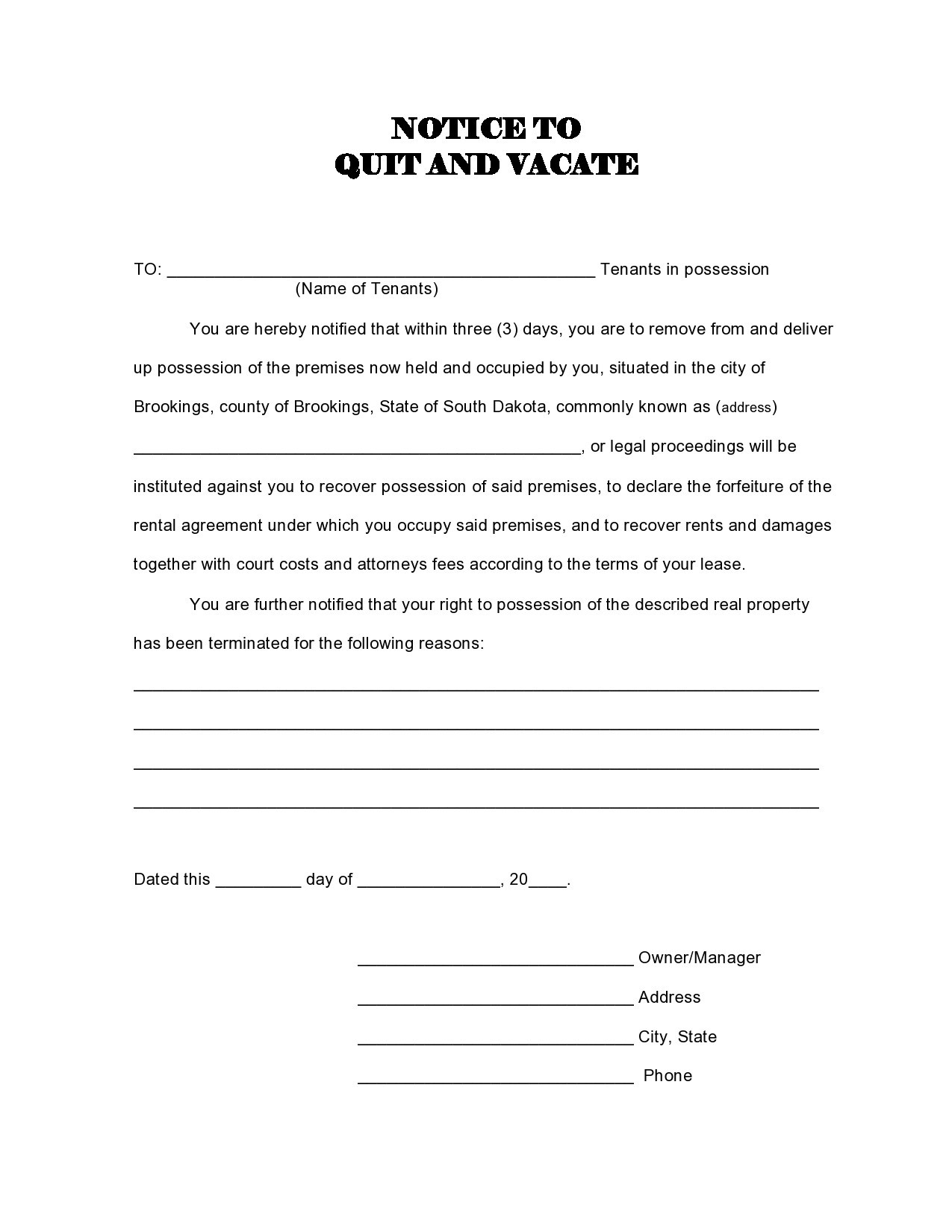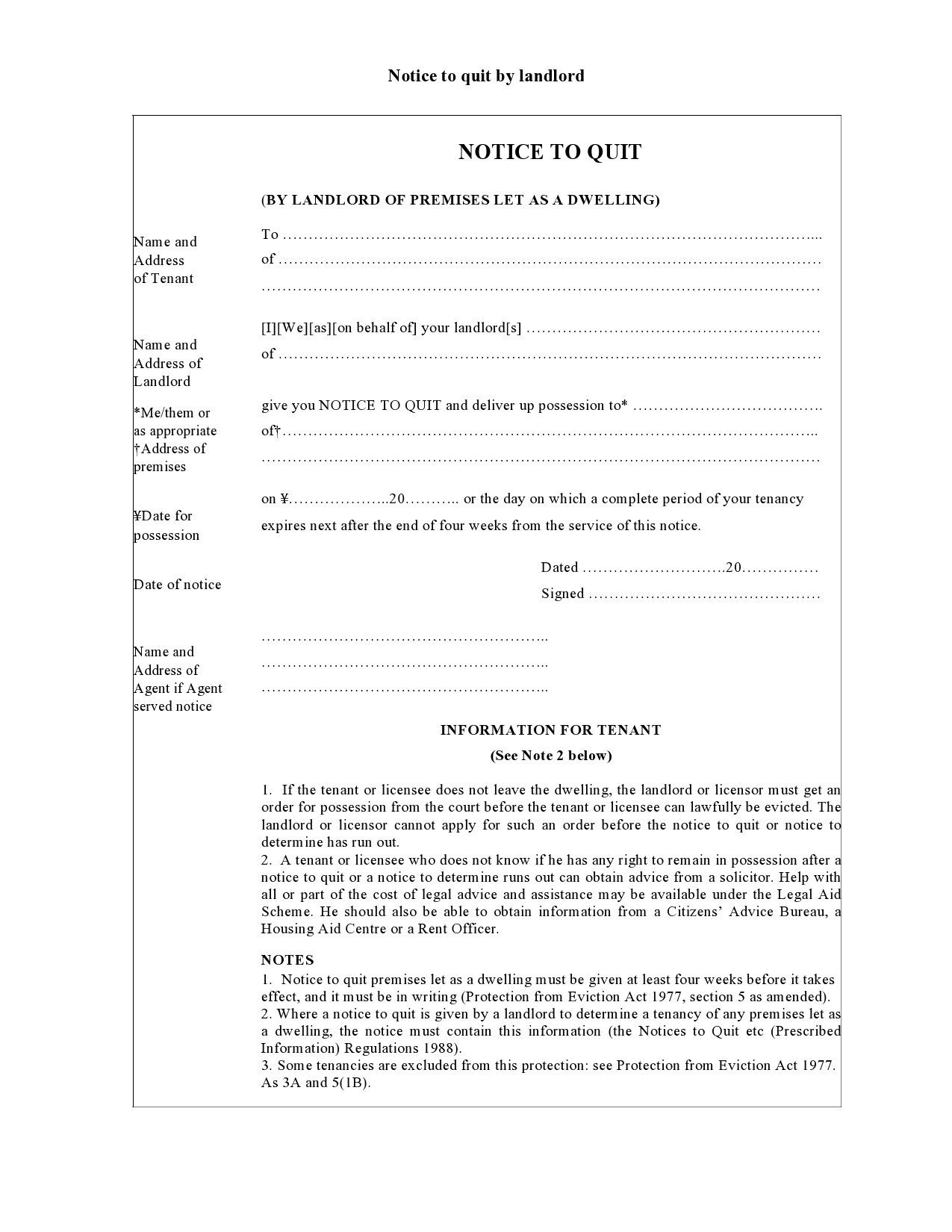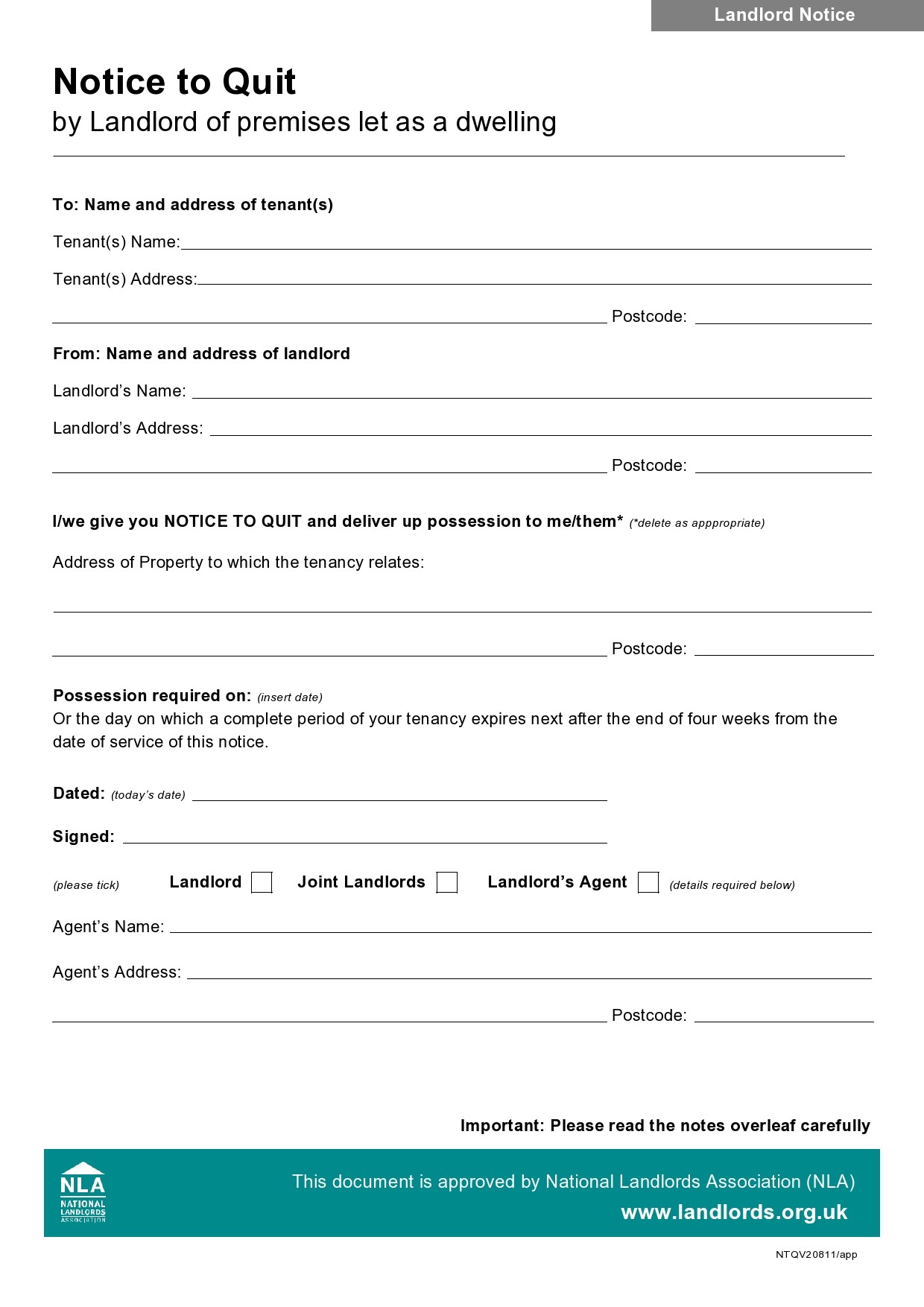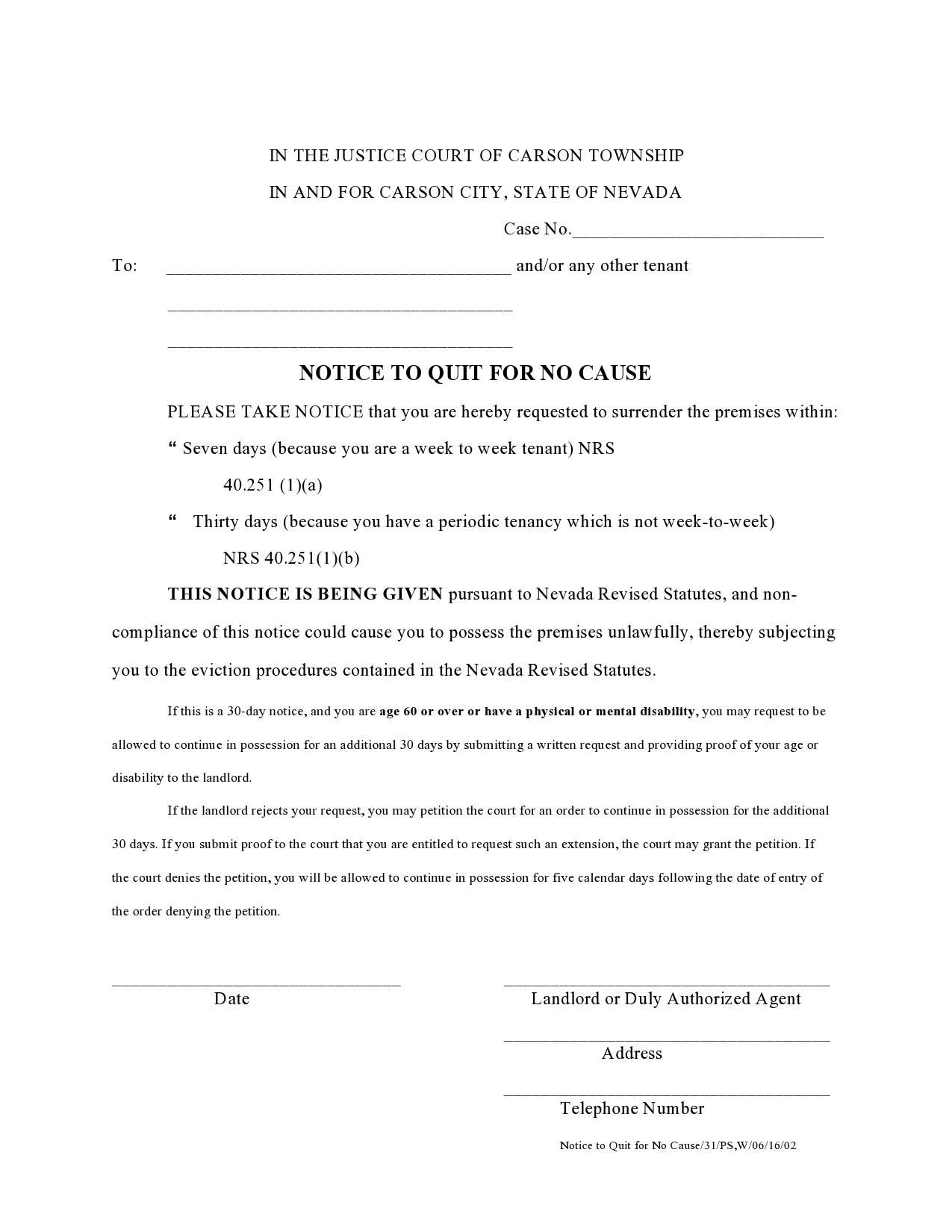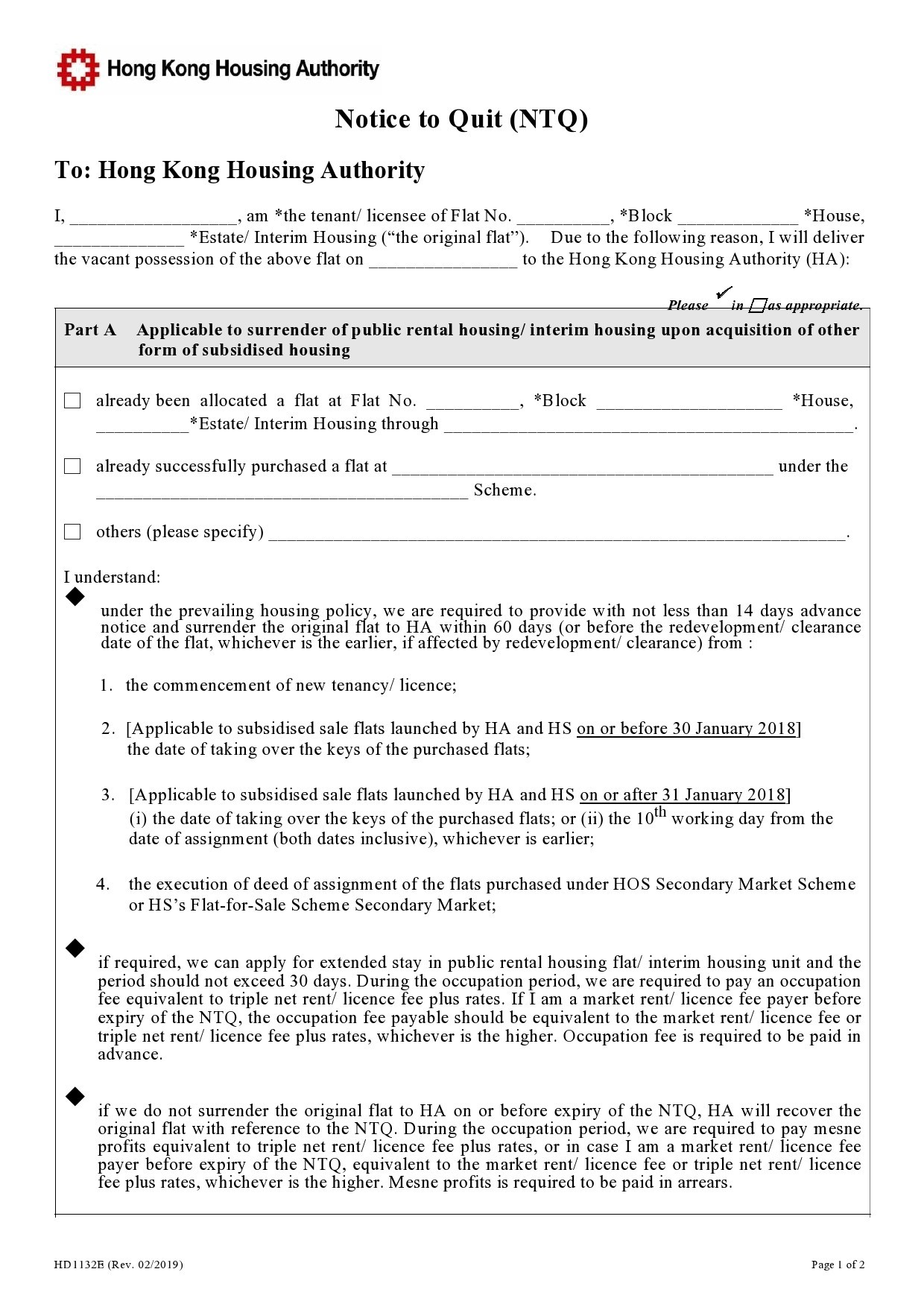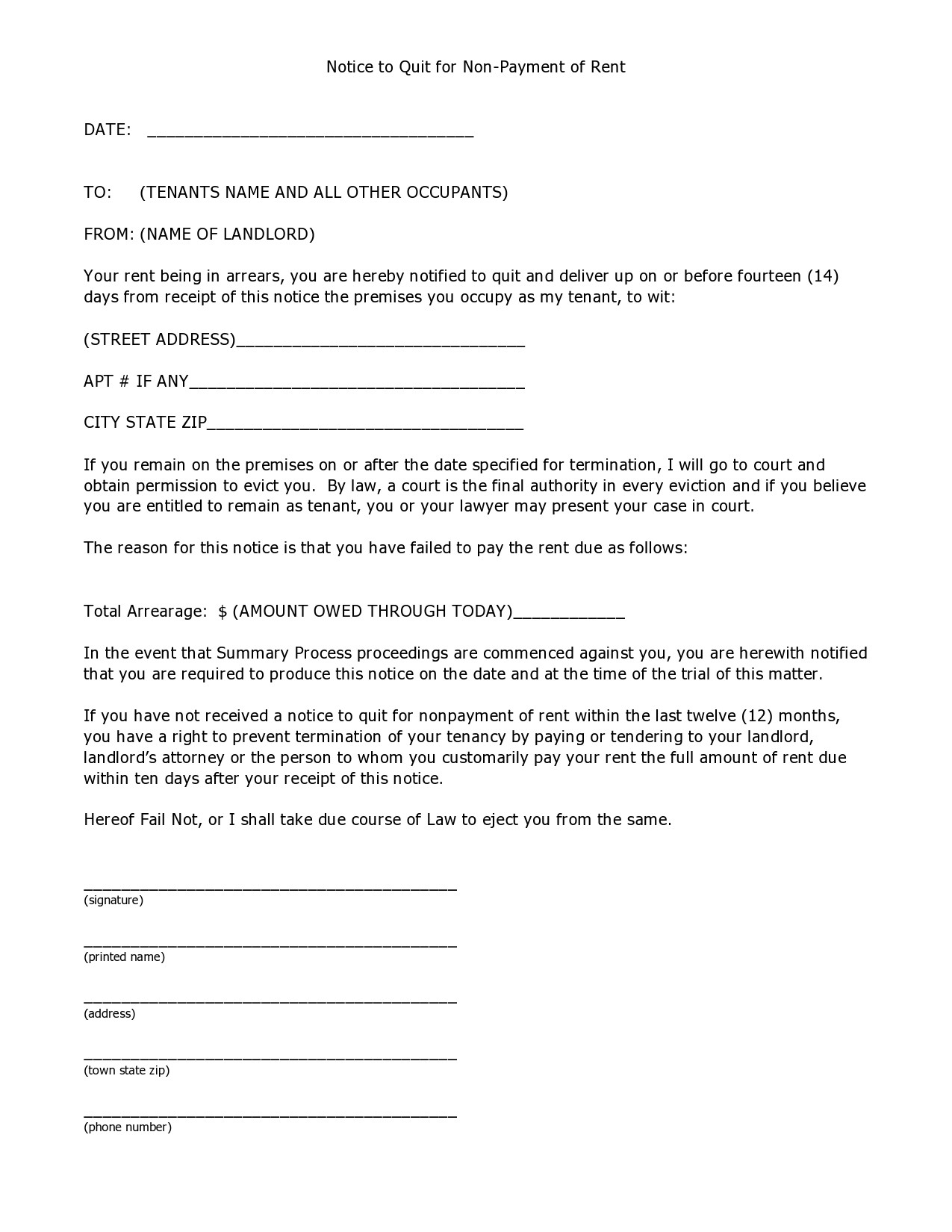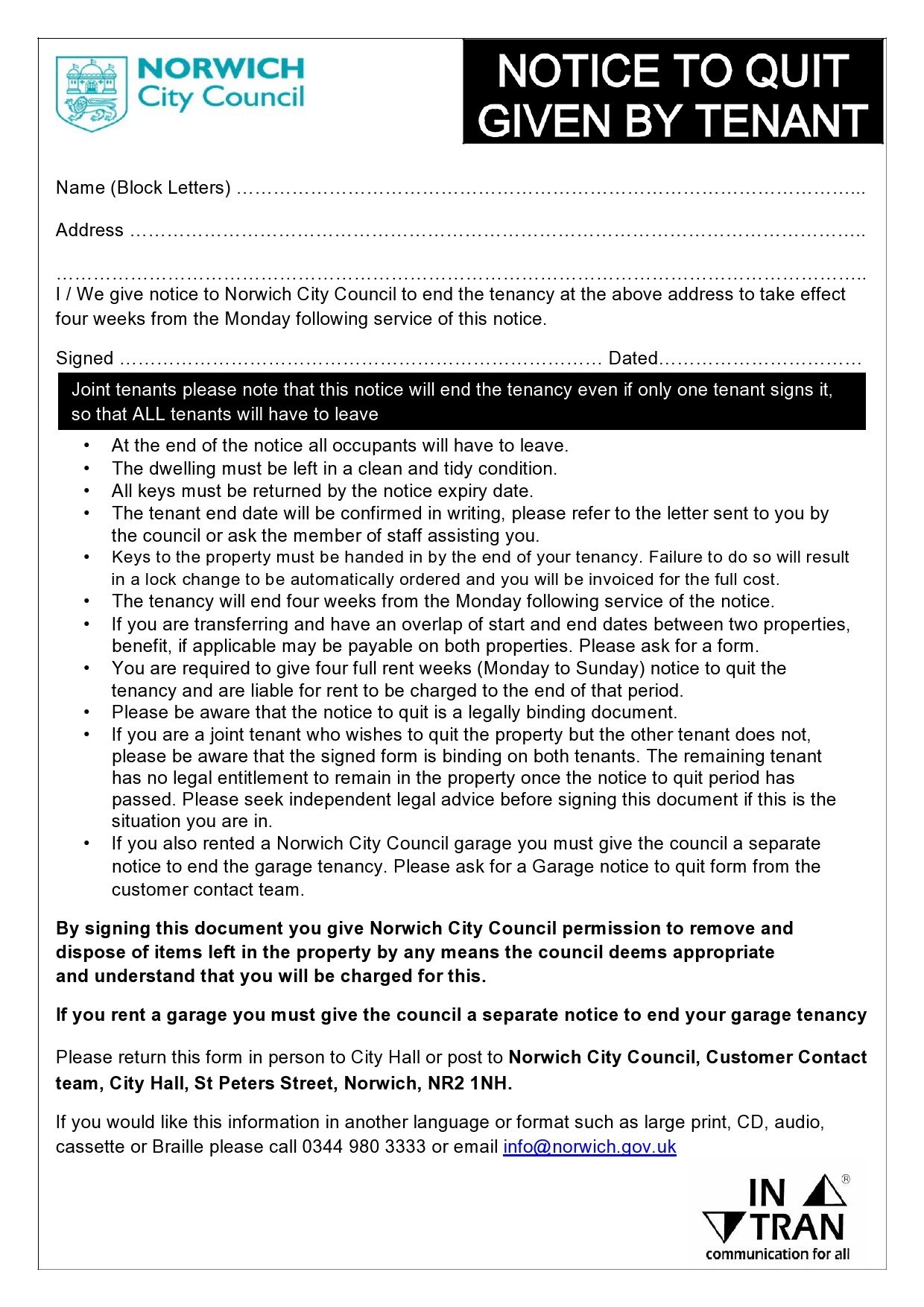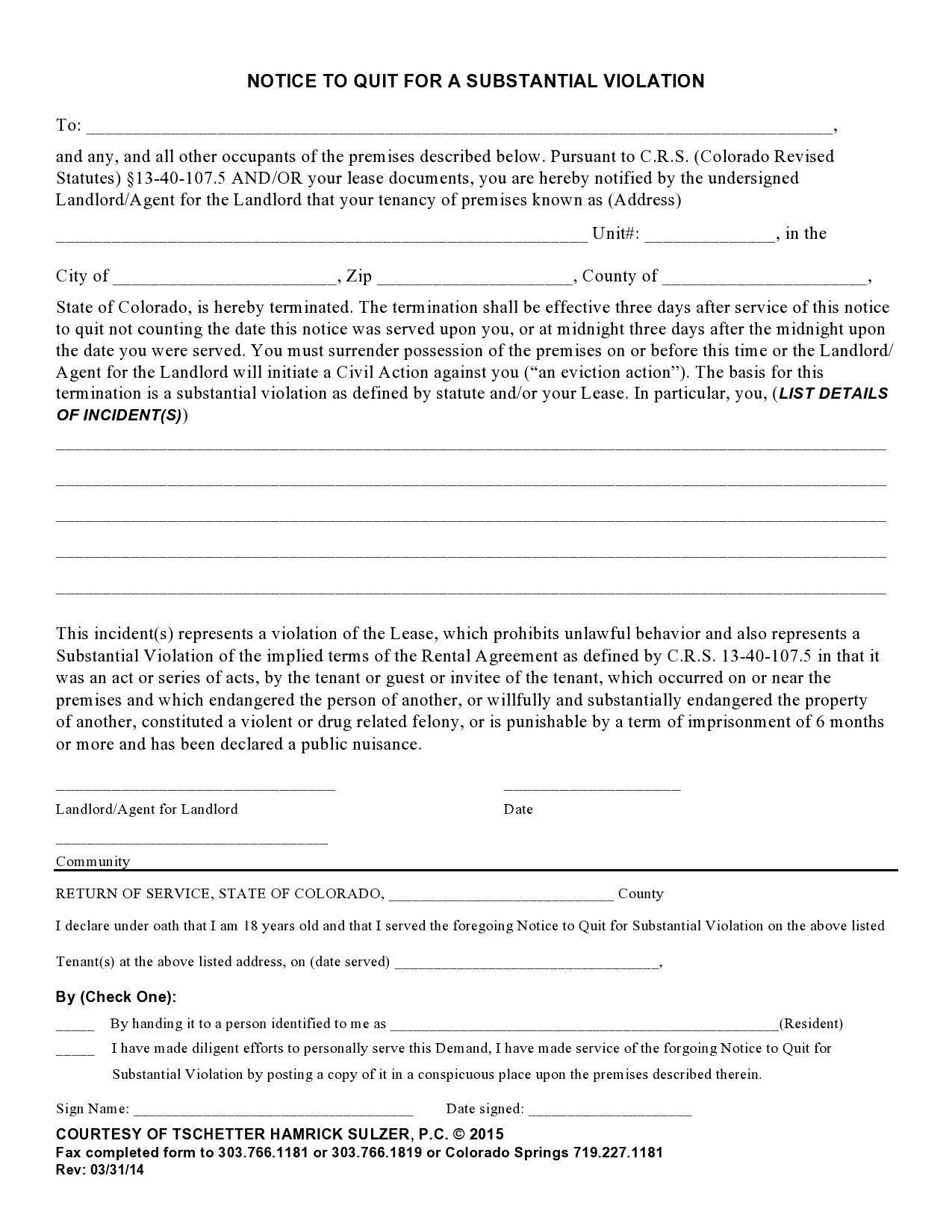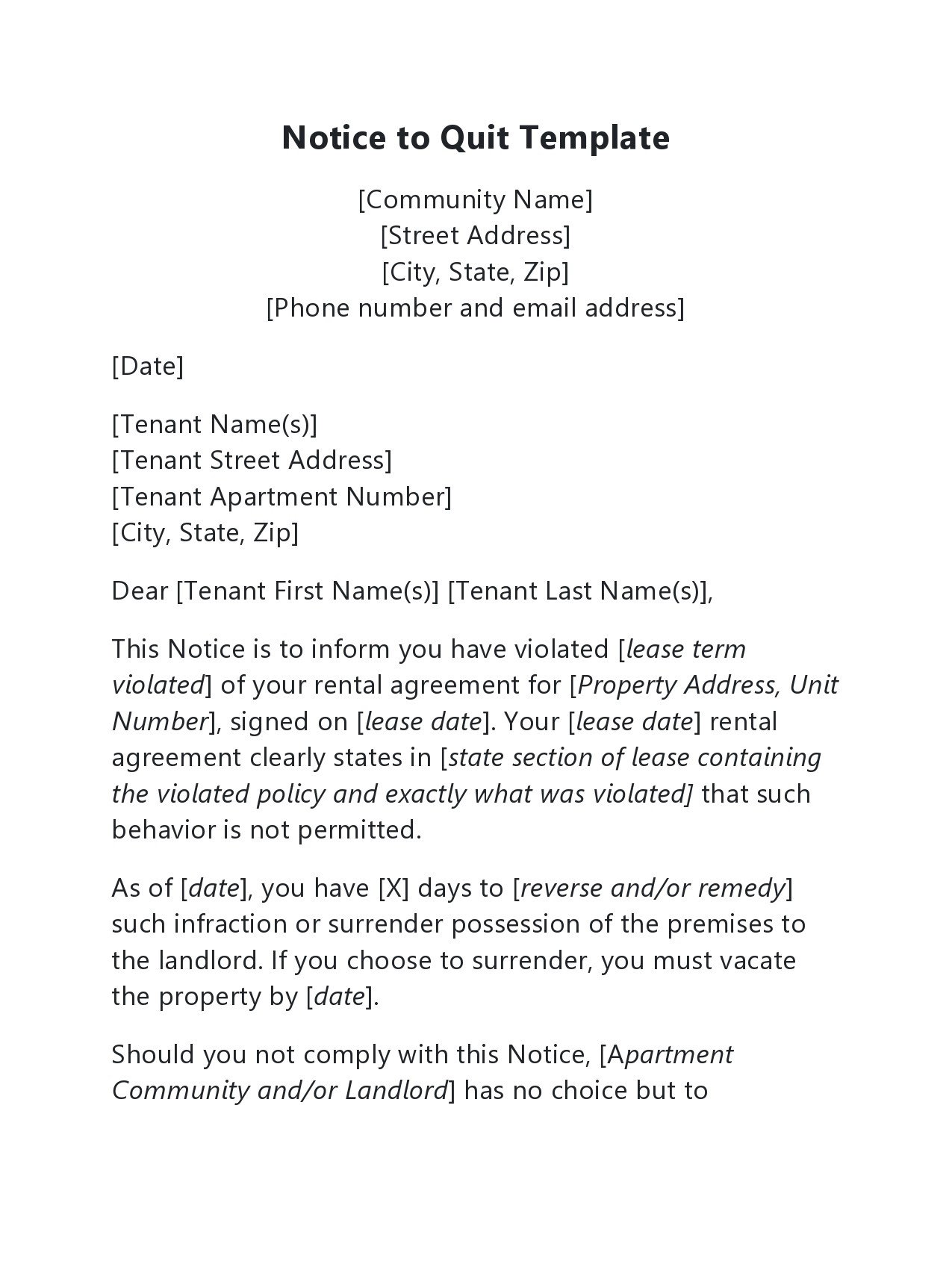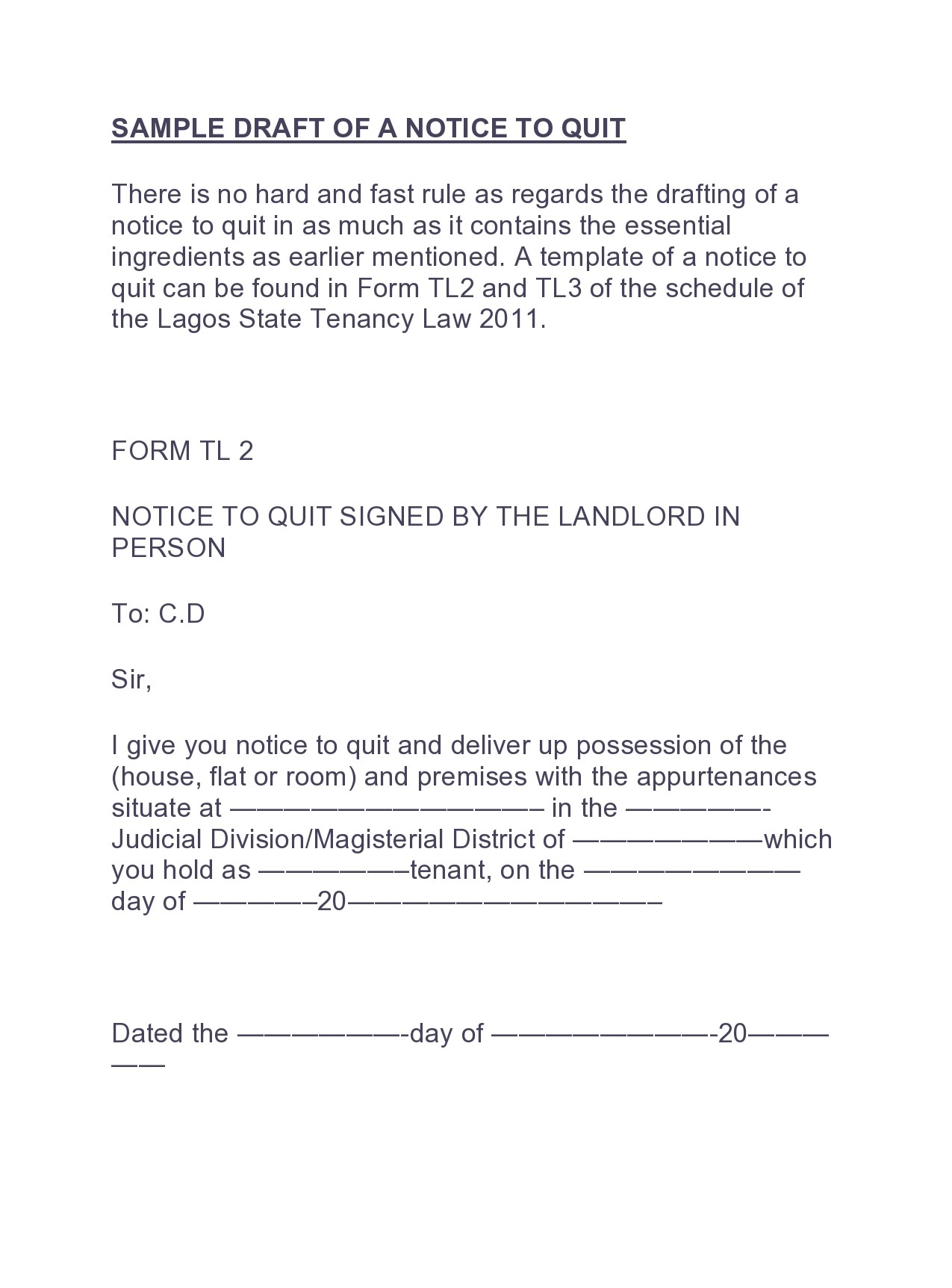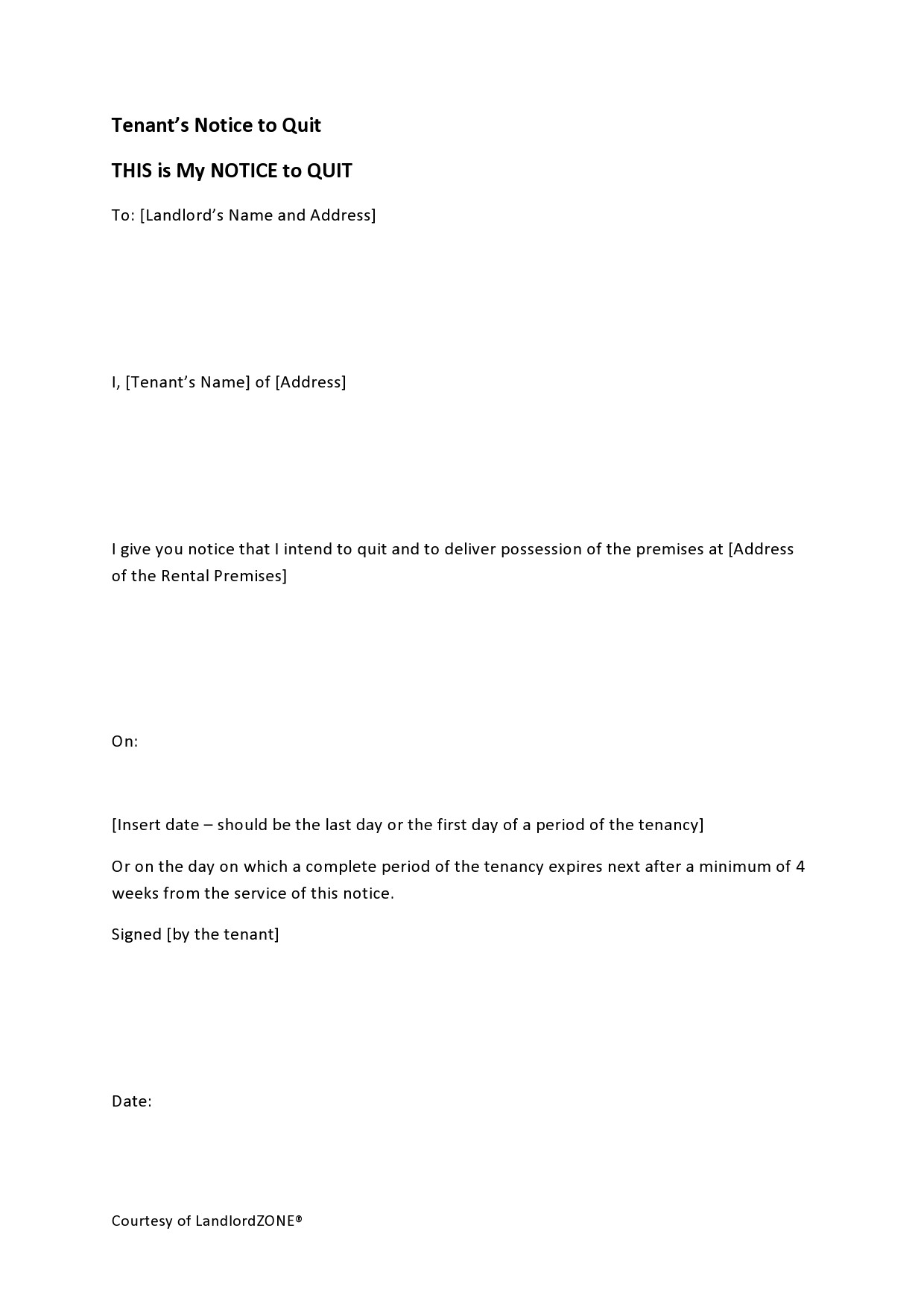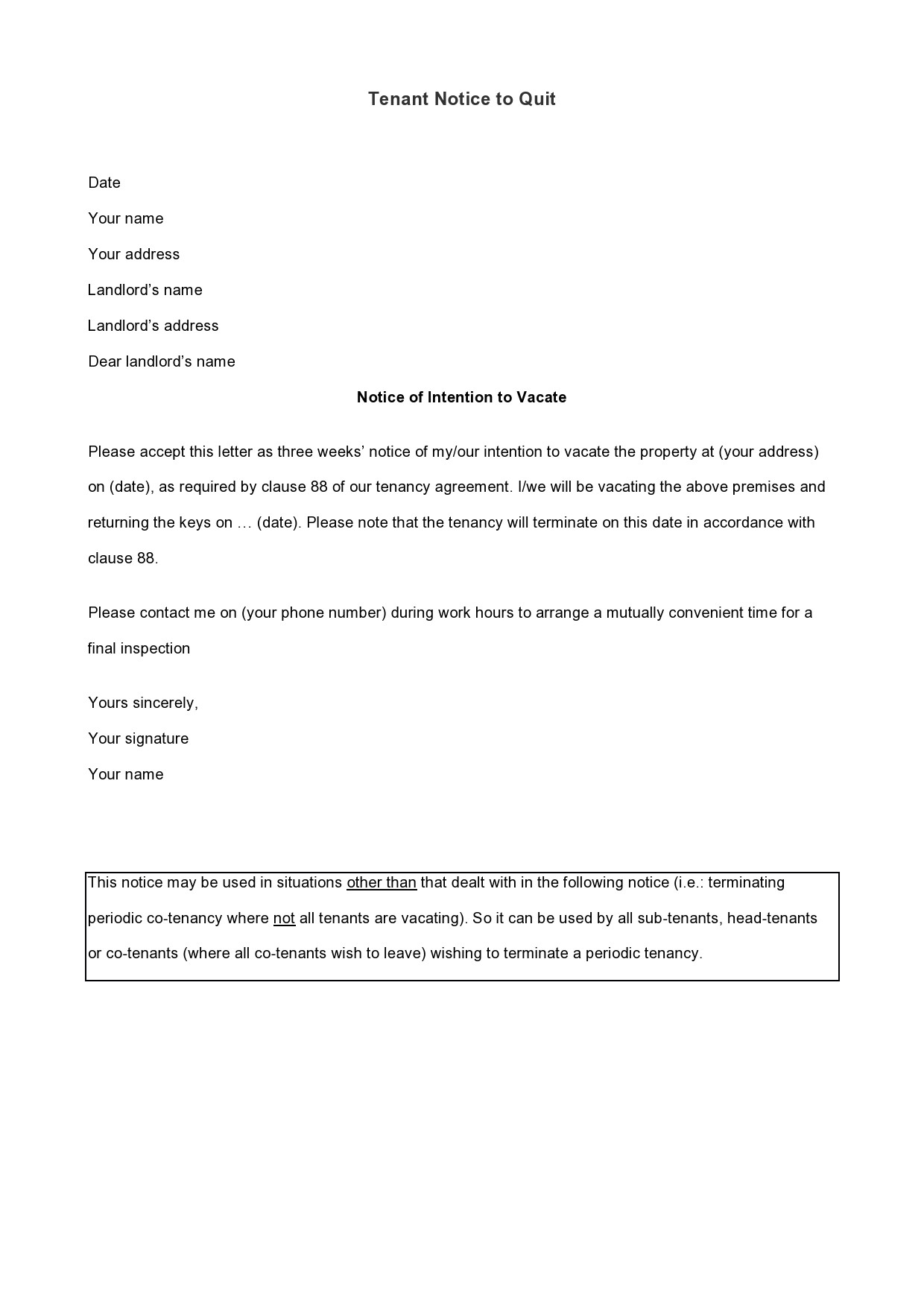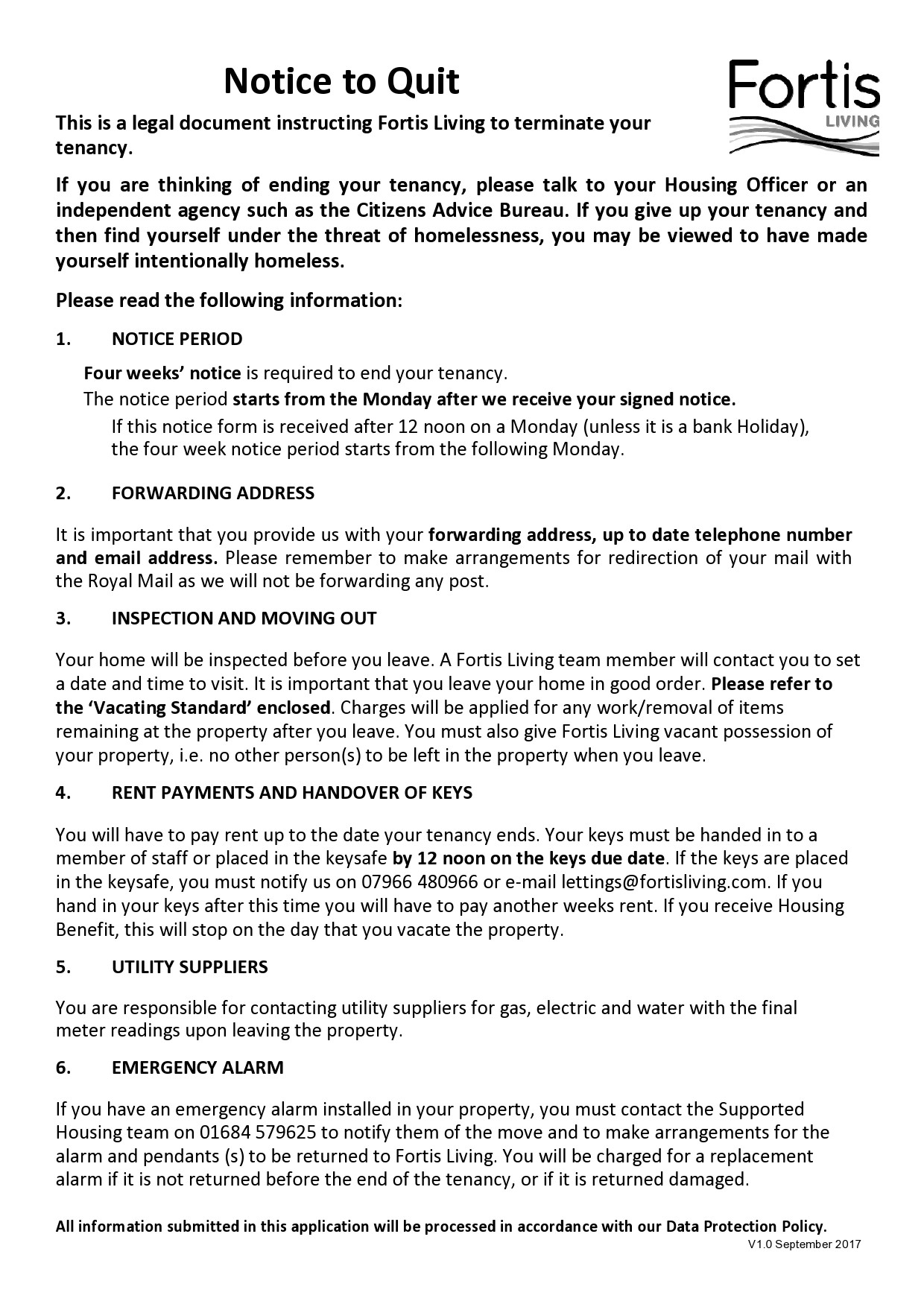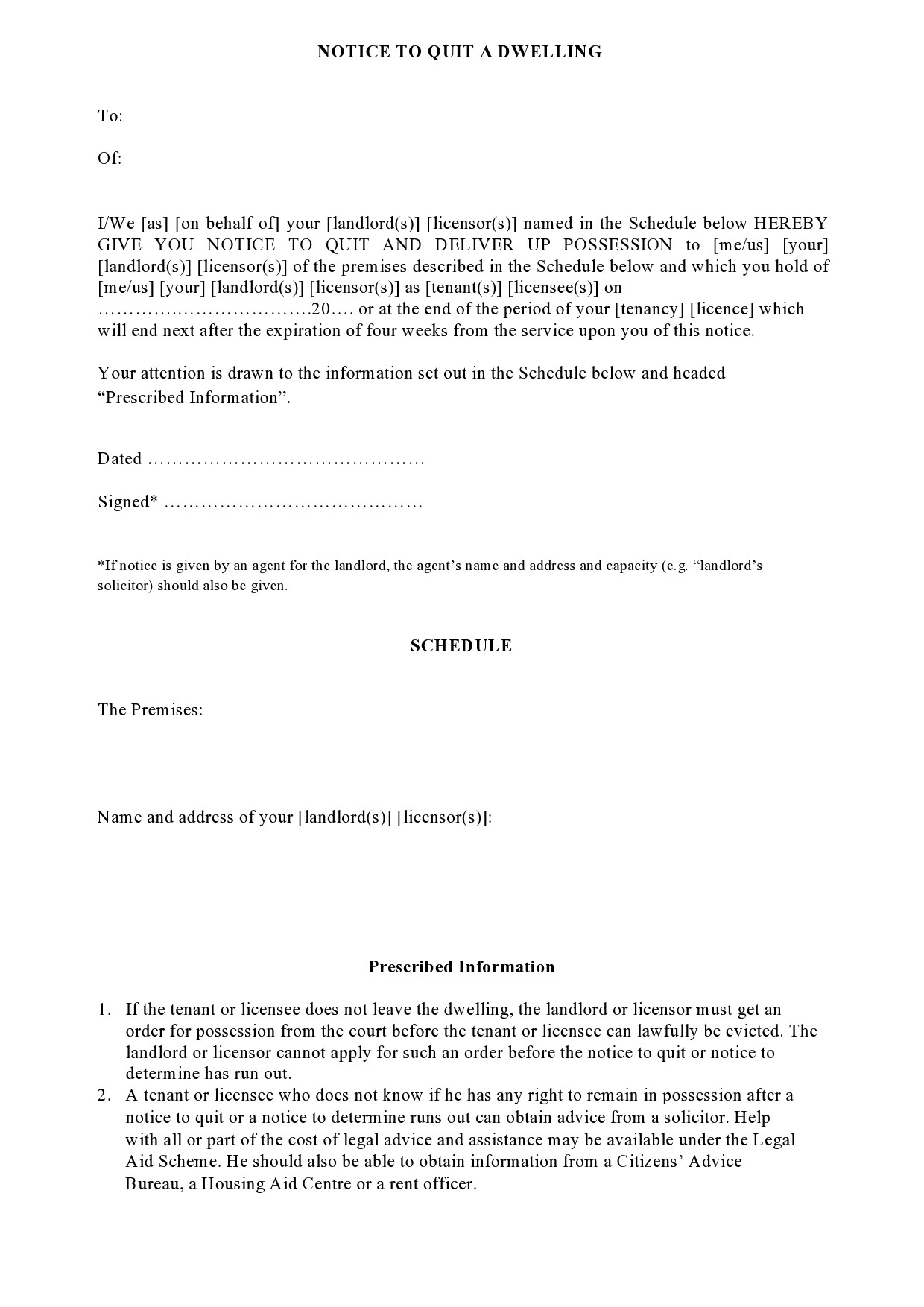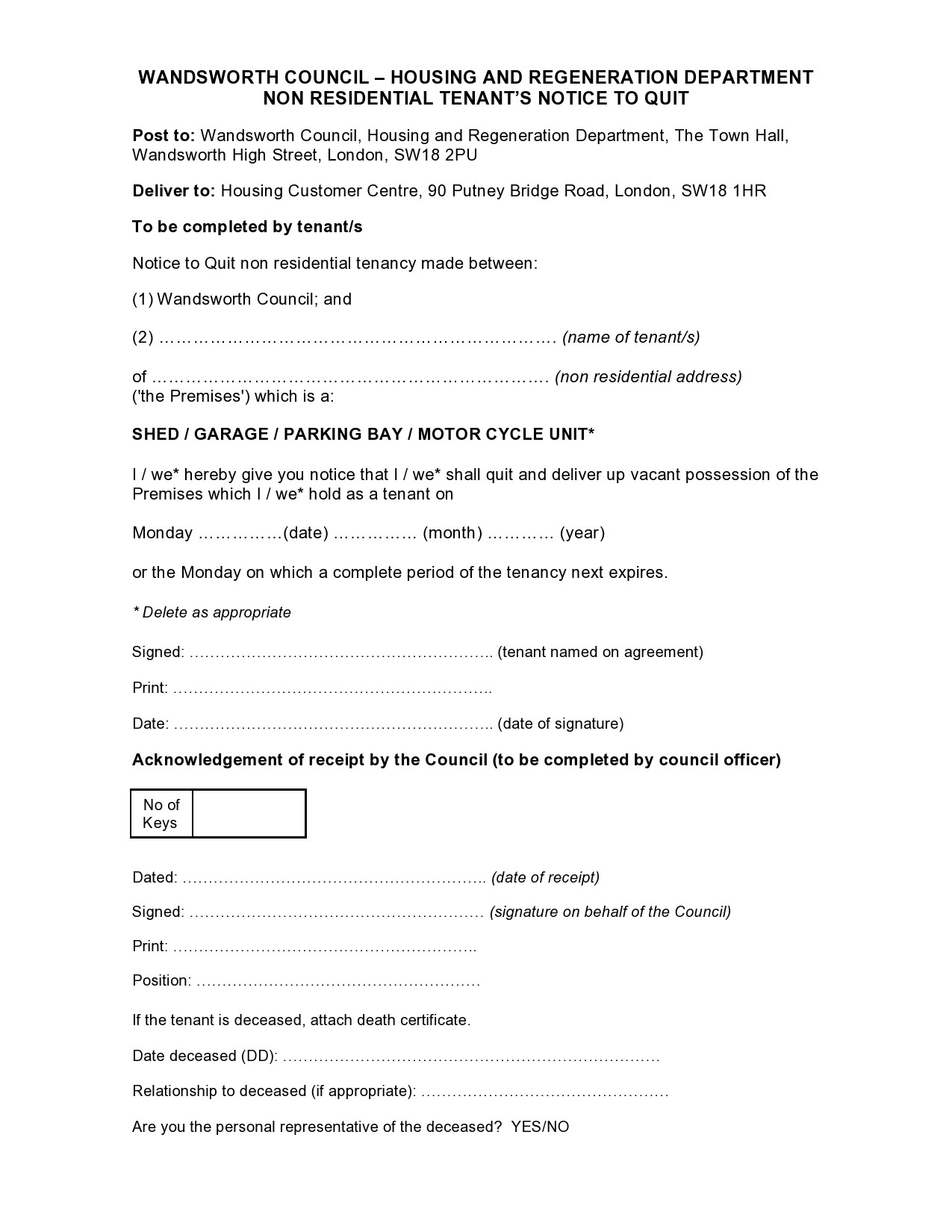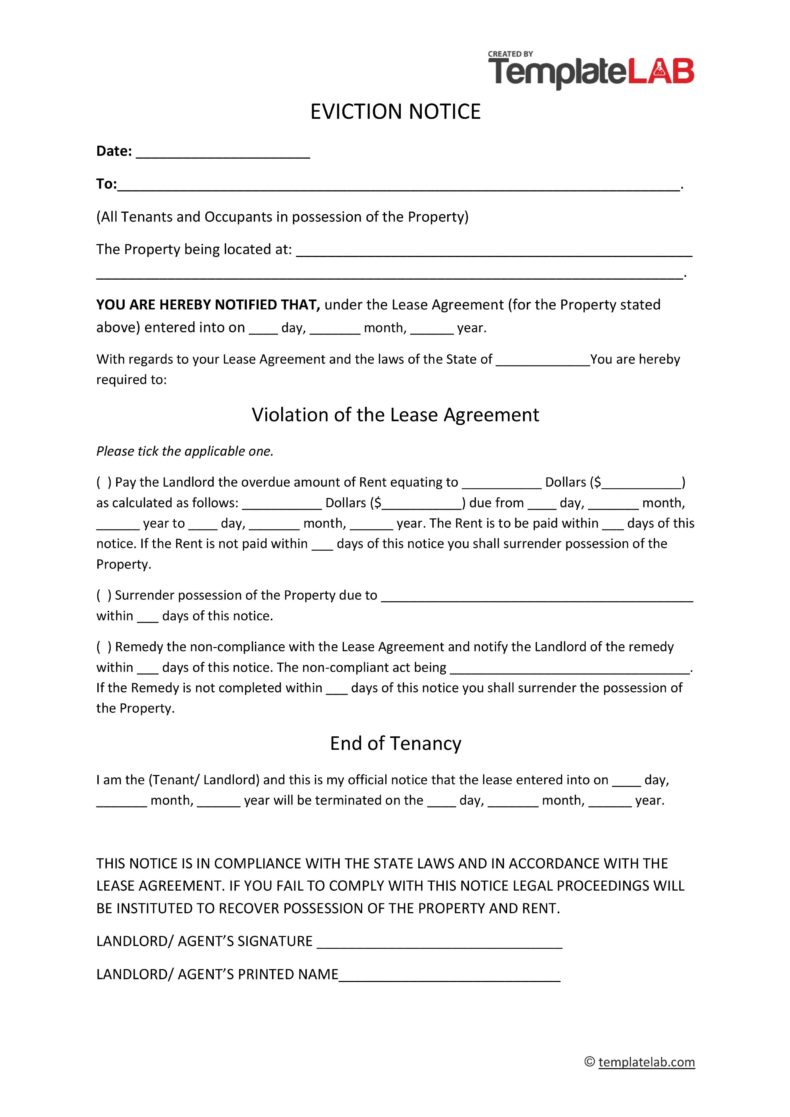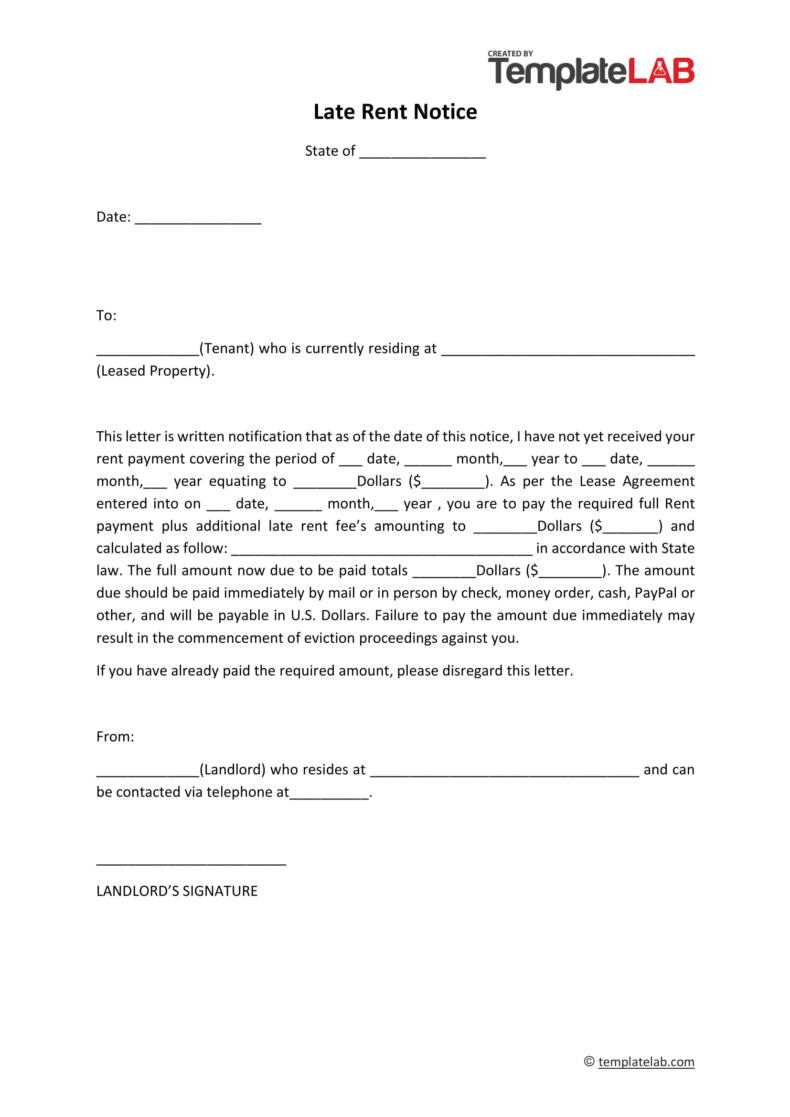When a tenant signs a lease agreement with their landlord, they agree to follow all of the terms that are listed on the lease. If the tenant breaks a clause in the contract, the landlord will need to take the necessary steps to rectify the problem. This often includes a time period for the tenant to fix the mistake in case it was made by accident.
Table of Contents
- 1 Notice to Quit Templates
- 2 What is a Notice to Quit?
- 3 Notice to Pay Rent or Quit
- 4 What is an Unconditional Notice to Quit?
- 5 What are the Reasons to Send a Notice to Quit?
- 6 Notice to Quit by Landlord
- 7 What are Some of the Common Lease Violations?
- 8 Quit Notice Letters
- 9 Who Should be Listed on the Notice to Quit?
- 10 How Do You Send a Notice to Quit?
- 11 Notice to Quit Forms
- 12 When Should a Landlord Send a Notice to Quit?
- 13 The Tenant Response to the Notice to Quit
- 14 FAQs
The first step the landlord must take is to send out a Notice to Quit the behavior. The tenant will get a certain number of days to stop or fix the lease violation. If the tenant refuses, then the landlord can start the process of filing an eviction. There are certain rules the tenant and the landlord must follow before any of this can happen.
Notice to Quit Templates
By State
What is a Notice to Quit?
The first thing to look at is what a Notice to Quit is all about. This is a formal legal document that the landlord will send to a tenant when they want to fix a violation of the lease. In many situations, this needs to be sent to the tenant before the landlord is able to file to evict the tenant.
The point of sending out the Notice to Quit is that it provides the tenant a chance to fix the issue within a certain number of days. Sometimes the issue is small enough that the tenant can fix it, such as moving out an extra tenant who is not supposed to be inside of the property or fixing stuff that got broken.
If the tenant gets the Notice to Quit and does not fix the lease violation within a certain number of days, then the landlord is able to start the eviction against them. That can take some time to complete, but will effectively remove the tenant from the property for not following the clauses in the lease contract.
Notice to Pay Rent or Quit
What is an Unconditional Notice to Quit?
Unlike the traditional notice to quit, an unconditional notice will require that the tenant will vacate the property and they will not be given a chance to fix the violation on the lease. This is generally only sent if the tenant is participating in illegal activities and the landlord needs to get them out as quickly.
Unlike what we see with an eviction, which can be a lengthy legal process, the unconditional notice is going to require the tenant to get out of the property right away. Whether the landlord can send this notice to quit can depend on the local laws. They must check with the local attorneys to see if this is allowed.
What are the Reasons to Send a Notice to Quit?
There are a lot of different reasons to send out a Notice to Quit to your tenant. This notice can be given because the tenant violates a clause within the lease agreement. It is also possible that the landlord will send this out if there are external factors at play unrelated to the tenant, such as the property no longer being on the rental market.
Some of the common reasons that the landlord would send this kind of notice includes:
- There are individuals living in the apartment who is not named as the tenants within the lease agreement.
- The tenant has not done a good job of keeping the unit clean and habitable during their stay there.
- There is a no pets policy in place and the tenant has a dog or cat.
- The tenant has made too much noise consistently and the neighbors and others are complaining.
No matter what the reason is that you file the Notice to Quit, you must spell out the reason within the notice before presenting it to the tenant. It will be voided if the tenant gets this notice and has no idea why you sent it or what they must do to fix the problem. You will have to send another one out and restart the whole process if you miss this step.
Notice to Quit by Landlord
What are Some of the Common Lease Violations?
There are a lot of different issues that can happen when it comes to a lease violation. It will depend on the lease and the terms that are listed on it in the first place. The landlord will need to make sure that any lease violation they state makes sense for the agreement between them and the tenant.
Anything that goes against the lease that the tenant and the landlord put in place will require one of these notices. The landlord should present this in writing to make sure they leave a paper trail. The tenant may feel like this takes it too far, but it helps the landlord begin the process if they need it.
However, if the tenant complies or voluntarily leaves, then that is the end of the process. There is no need for the landlord to continue the eviction process or any of the other steps. The tenant is usually given a chance to fix the problem, as long as they are not participating in any illegal behaviors or activities while at the property.
Quit Notice Letters
Who Should be Listed on the Notice to Quit?
When the landlord serves a tenant with this Notice to Quit, they must make sure to include all of the names of the tenants on the notice. This means that all of the adult members who live in that property should be listed on it to avoid confusion.
Sometimes a landlord may want to just put the offending tenant on the Notice to Quit. This is not a good idea. It can send the wrong message and slow down the proceedings if the tenant does not comply. Look through the original lease document and write down the full legal name of those who signed it.
In addition to the full legal names of the tenants, you also need to include information like:
- The address of the rental property in question.
- The floor of the apartment if that is relevant.
- The exact unit number where the tenants are residing.
- The landlord, or the representative of the landlord, will need to both sign and date the Notice.
Fill out all of this information as completely as possible. This can help avoid any confusion and will make it easier to start the conviction process if necessary later on.
How Do You Send a Notice to Quit?
Each state will have its own rules when it comes to the correct method for delivering the Notice to Quit. You will need to check the eviction laws in your state.
In some areas, the landlord, or their representative if they are a larger company, will need to serve this Notice in person to the tenants. Others allow the Notice to Quit to be sent through first-class certified mail rather than doing this in person. Still other states will require the Notice to be delivered formally through the state marshal.
The landlord will need to read up on the rules of how this Notice must be delivered in their own state. For example, if you send it by mail but are required to deliver it, then it may not be valid and you will have no recourse or will need to start again.
Notice to Quit Forms
When Should a Landlord Send a Notice to Quit?
The reason a landlord plans to evict the tenant will often determine when you would like to send out the Notice to Quit. In most areas, the landlord must serve this notice a minimum of three days before an eviction is filed. There are also some reasons that will take longer and you may need to give more than three days’ notice to the tenant.
Take a look at the rules in your area. There are situations where you will need to give the tenant a document known as the Notice to Cease before you serve them with a Notice to Quit, which is another step in the process. A landlord may choose to serve the tenant with this first notice if they tend to disrupt other tenants in the building. If they do not stop once the Notice to Cease has been served, then the landlord can move to the next step with the Notice to Quit.
The Tenant Response to the Notice to Quit
Once the landlord has property sent out the Notice to Quit to the tenant, they will need to wait for the tenant to respond. There are a few ways that the tenant can choose to respond. They may decide to obey the notice and either fix it or move out, or they may decide to disregard the notice and wait out the eviction.
Tenant Obeys Notice
The tenant may receive the Notice to Quit from the landlord and realize that an eviction is about to happen if they do not fix the problem as soon as possible. This leaves them with a few options to consider:
- The tenant will fix the issue with the landlord, getting up to date on rent, fixing what is broken, or removing the pet.
- The tenant will agree to voluntarily move out of the property before going to court.
If the problem is something the tenant is able to fix, they will generally work on the first one so they can stay in the property and not have to move. In some cases, the tenant is not able to fix the problem in the given timeline. They can choose to move out of the property voluntarily, which helps them avoid an eviction on their record. This can make it easier for them to rent another place later on.
Tenant Disregards Notice
It is also possible that the tenant is going to disregard the notice that the landlord sends to them. They may have no desire to get up to date on some of the things they failed within the contract or the lease and they know it will take the landlord a month or more to get a formal eviction going.
Their goal is to buy some more time until they can find a new home since you will not be able to do it right away. Some tenants may be willing to fight the problem out in court, and so will wait it out because they don’t think they have done anything wrong.
FAQs
What Happens After a 3-Day Notice to Pay or Quit?
If the tenant does not pay or fix the problem before the notice, then the landlord will have to decide how to proceed. The next step is often to start with eviction. The landlord should start this as soon as the Notice to Quit time has expired. This will save time and only gives the tenant a month before it is complete.
Can the tenant fix the problem on the Notice before eviction?
It is possible for the tenant to receive the Notice and realize that your next intention is to file for an eviction. They may take the necessary steps to try and rectify the problem. You can then withdraw the Notice and let them continue on, assuming they will agree to keep following the rules of the lease. The tenant may choose to move out to avoid an eviction, or the landlord will be able to file the eviction.
Can I do an eviction without a Notice to Quit?
The landlord will need to send a Notice to Quit to the tenant before they are able to begin any of the eviction processes. And the steps need to be done right, with the landlord submitting it to the tenant at the right time, the right names in place, and the tenant given enough time to fix the problem or leave. In some areas, the landlord will need to send out a Notice to Cease first to help prevent issues and give the tenant more time to respond. This all needs to be done before the eviction process.

